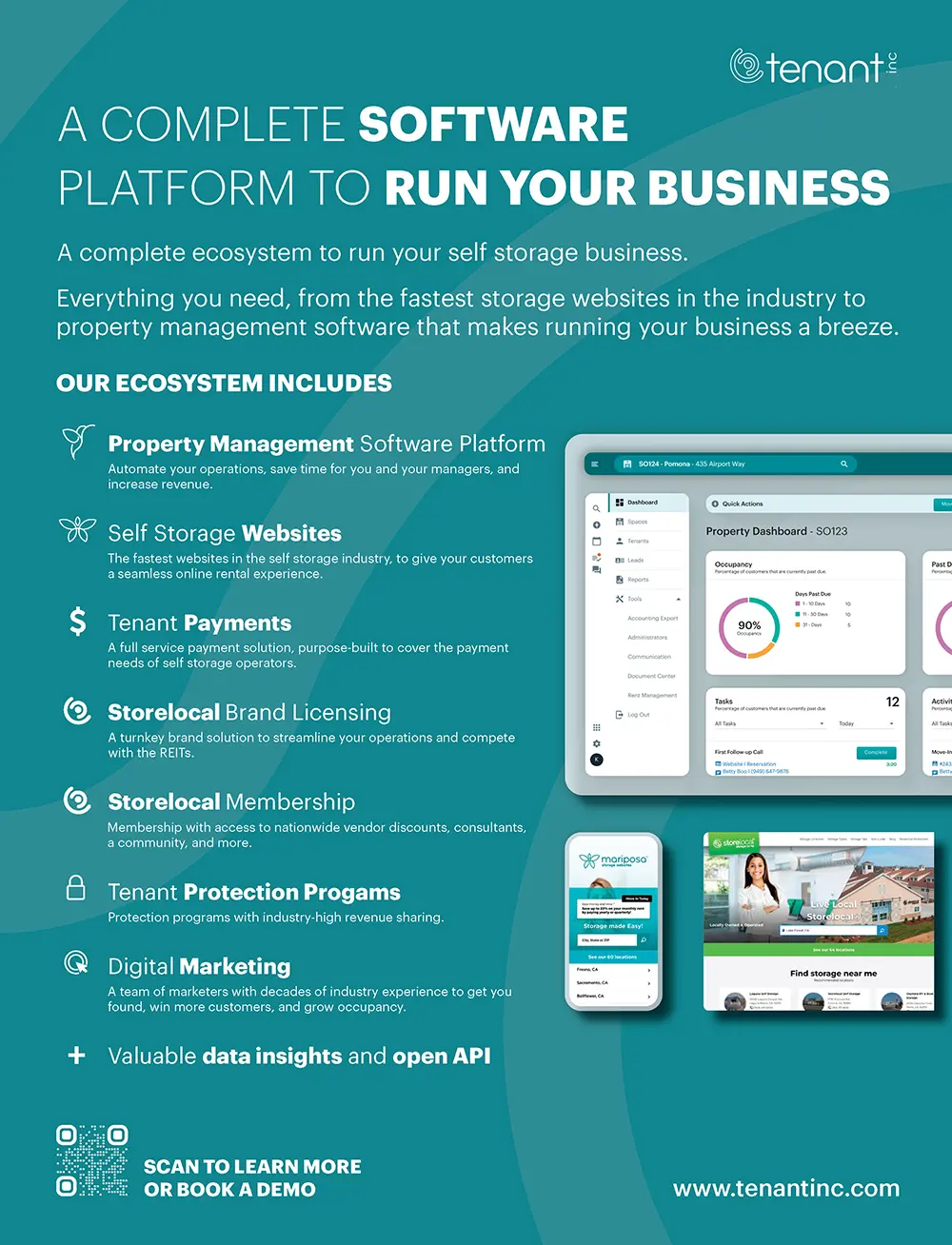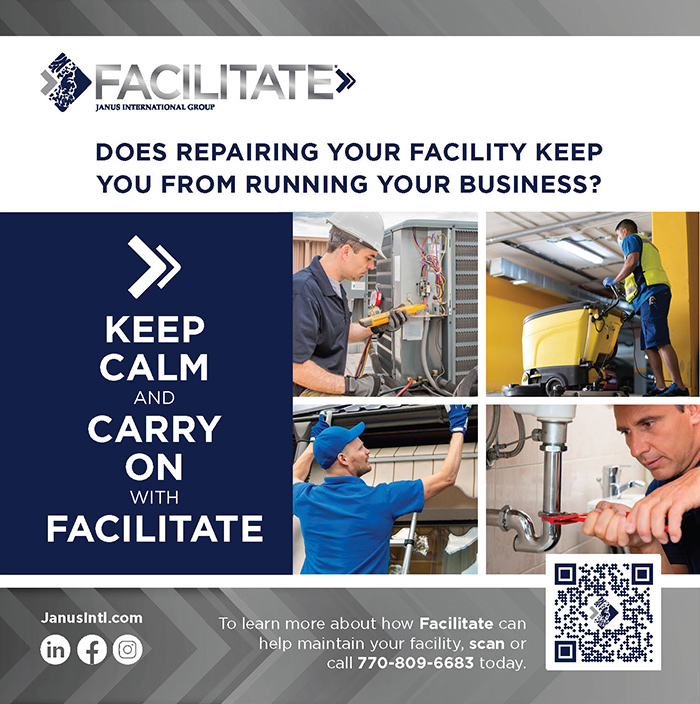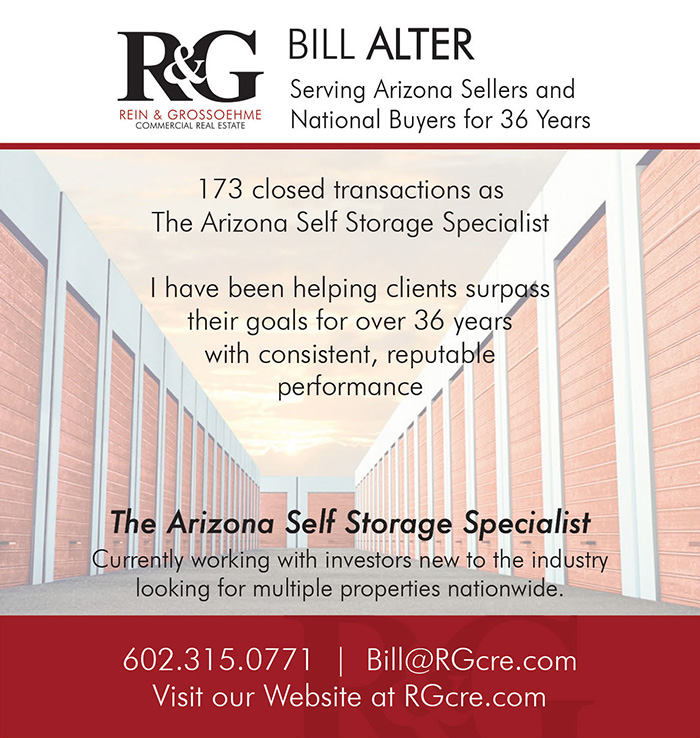How to enjoy our new magazine:
Just scroll!
Click or tap the table of contents icon in the menu bar to find any article.
Read any article by clicking or tapping the read full article button below each article intro.
Jump back to your previous browsing spot from any article using the menu bar or back to issue button.




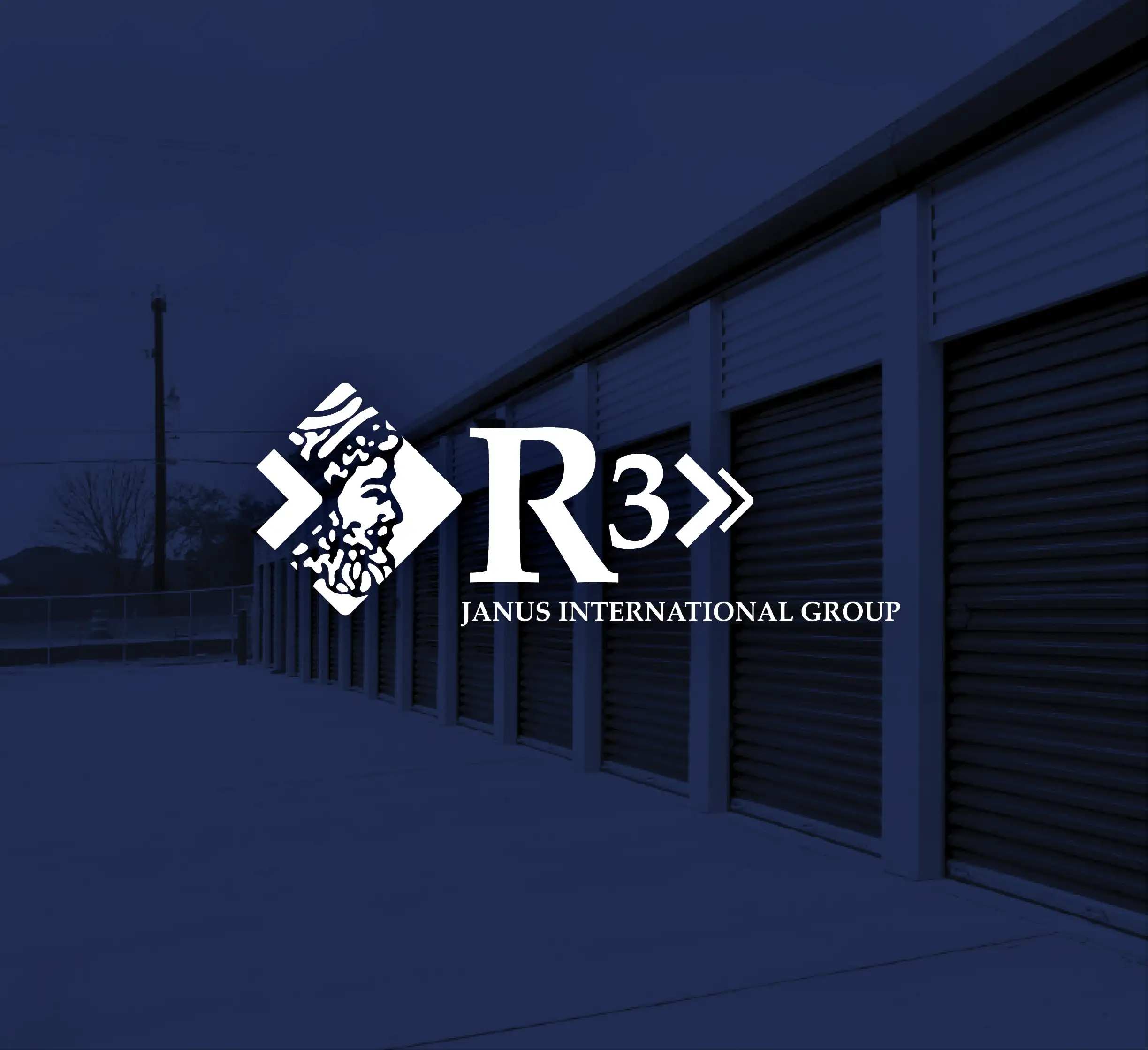

-
Facing The Most Common Management ChallengesPage 14
-
Exploring AI-Driven Management SolutionsPage 16
-
Page 30
-
Yardi Matrix Q4 2023 Self-Storage Supply ForecastPage 32
-
Five Misconceptions About Building Self-StoragePage 102
-
7200 Monogram Self StoragePage 104
- Chief Executive Opinion by Travis Morrow 6
- Publisher’s Letter by Poppy Behrens 9
- Meet The Team 10
- Women In Self-Storage: Angie Guerin by Erica Shatzer 21
- Who’s Who In Self-Storage: John Traver by Erica Shatzer 25
- StorageGives 111
- Self Storage Association Update 114
- The Last Word: Mike Burnam 116
For the latest industry news, visit our new website, ModernStorageMedia.com.

e has to be. Where else are you going to keep 8 billion presents before Christmas? There’s definitely a facility at the North Pole. Merry Holidays from the entire MSM team and a Happy New Year!
He’s also the president of National Self Storage.

-
PUBLISHER
Poppy Behrens
-
Creative Director
Jim Nissen
-
Director Of Sales & Marketing
Lauri Longstrom-Henderson
(800) 824-6864 -
Circulation & Marketing Coordinator
Carlos “Los” Padilla
(800) 352-4636 -
Editor
Erica Shatzer
-
Web Manager / News Writer
Brad Hadfield
-
Storelocal® Media Corporation
Travis M. Morrow, CEO
-
MODERN STORAGE MEDIA
Jeffry Pettingill, Creative Director
-
Websites
-
Visit Messenger Online!
Visit our Self-Storage Resource Center online at
www.ModernStorageMedia.com
where you can research archived articles, sign up for a subscription, submit a change of address. 
- All correspondence and inquiries should be addressed to:
Modern Storage Media
PO Box 608
Wittmann, AZ 85361-9997
Phone: (800) 352-4636
elcome to the December issue of Messenger, our annual Facility of the Year edition! Started in 1986, this competition has grown from one that requested a simple 2,000-word submission into one in which entry binders include input from the entire development team. Binders contain site maps, unit layouts, facility renderings, and photos that detail the entire construction process, including each challenge that had to be overcome. Today, under our new banner as Modern Storage Media, we are proud to announce that the facility of the year program will go on and become stronger than ever!
We are excited to announce the 2023 Messenger Facility of the Year winners:
- Overall Winner – Arizona Self Storage in Tucson, Ariz.
- Unmanned Winner – StoreEase in Tooele, Utah
- Construction Winner – Morningstar Storage in Baltimore, Md.
- New Facility Winner – Valley Storage in Knoxville, Tenn.
- Smart Winner – Superior Storage in Tyler, Texas
- International Winner – Mr. [B] Self Storage in Curridabat, Costa Rica
- Green Winner – Greens Storage in Escondido, Calif.
In addition to commending this year’s winners, we would also like to congratulate the many owners, operators, and development teams behind every nominated facility. Your contributions to the self-storage industry continue to drive us forward, not only in terms of design and operations but also in terms of professionalism and excellent customer service.
Last but not least, if you haven’t done so already, there is still time to pre-order the 2024 Self-Storage Almanac. For details about this special discounted offer, read here. The 2024 Almanac will feature all new data from our exclusive data provider Radius+ as well as an RV and boat section compiled by Yardi Matrix. You may also pre-order the Almanac by visiting www.modernstoragemedia.com.
During the holiday season here at Modern Storage Media, our thoughts turn gratefully to those who have made our success possible. It is in this spirit that we say thank you and best wishes for the holidays and New Year!

Publisher

 Merry Holidays and Happy New Year from the entire Modern Storage Media team!
Merry Holidays and Happy New Year from the entire Modern Storage Media team! 
elcome to the December issue of Messenger, our annual Facility of the Year edition! Started in 1986, this competition has grown from one that requested a simple 2,000-word submission into one in which entry binders include input from the entire development team. Binders contain site maps, unit layouts, facility renderings, and photos that detail the entire construction process, including each challenge that had to be overcome. Today, under our new banner as Modern Storage Media, we are proud to announce that the facility of the year program will go on and become stronger than ever!
We are excited to announce the 2023 Messenger Facility of the Year winners:
- Overall Winner – Arizona Self Storage in Tucson, Ariz.
- Unmanned Winner – StoreEase in Tooele, Utah
- Construction Winner – Morningstar Storage in Baltimore, Md.
- New Facility Winner – Valley Storage in Knoxville, Tenn.
- Smart Winner – Superior Storage in Tyler, Texas
- International Winner – Mr. [B] Self Storage in Curridabat, Costa Rica
- Green Winner – Greens Storage in Escondido, Calif.
In addition to commending this year’s winners, we would also like to congratulate the many owners, operators, and development teams behind every nominated facility. Your contributions to the self-storage industry continue to drive us forward, not only in terms of design and operations but also in terms of professionalism and excellent customer service.

 Merry Holidays and Happy New Year from the entire Modern Storage Media team!
Merry Holidays and Happy New Year from the entire Modern Storage Media team! 
During the holiday season here at Modern Storage Media, our thoughts turn gratefully to those who have made our success possible. It is in this spirit that we say thank you and best wishes for the holidays and New Year!

Publisher

- Breaking news updated daily
- Real-time sales and acquisitions updates
- A newly redesigned calendar of events
- Enhanced promotional opportunities for advertisers
The website also enables readers to submit news, events, and article ideas. Don’t forget to browse the MSM Store for dozens of exclusive, storage-specific publications, including three of the industry’s most trusted resources: the annual Self-Storage Almanac, The RV & Boat Development Handbook, and the annual Expense Guidebook. New publications are frequently added to its extensive list of offerings!




Modern Storage Media



Messenger

s a self-storage manager, you’re in charge of keeping your buildings in good shape, making sure they run at their best, keeping customers and employees safe, and staying within your budget. To keep your property running at its best, you will have to face a lot of challenges every day. We will give you some tips on how to deal with the most common ones.
Here are some areas that deserve your attention if you want to face challenges before they arise.
your facility might suffer a loss.”
Participating in significant industry events can help you be ready when members of your community ask you for advice or knowledge on self-storage issues. You’ll be prepared for any inquiry or request for an explanation if you do this. You must thus keep up with self-storage market news and do your research. To stay active in the sector while expanding your knowledge base, use the following strategies:
- Networking – You may join a number of national and regional self-storage organizations to network with other experts in the field. Networking and connecting with other professionals will give you the opportunity to share effective facility management strategies. Social media is at your disposal when looking for these particular groups.
- Industry Events – To broaden your expertise, make sure to consistently go to trade exhibitions, network, and learn more about storage facility marketing data, specialized operations, as well as the latest gadgets and up-to-date technology.
- Market Analysis – You must research your market to keep up with the times if you want to run a quality self-storage business. Consider doing this by configuring a self-storage-specific Google Alert system, which enables you to get weekly summaries of industry news. To monitor the success of the storage facility business, you may also wish to track the stock price movements of self-storage REITs.
- Tools For Convenience – You must get a deeper understanding of the services and goods that is available for your facility, including the hardware and software. There are many different software options, which makes managing the facility simpler and more convenient. For instance, some software companies integrate gate software, insurance providers, and payment information.
- Research The Competition – When visiting their facilities and analyzing their tenant benefits, unit amenities, and customer service, be sure to be aware of your main rivals’ prices. It would be preferable if you continued to keep ahead of the curve by undertaking competitive research to alter your services as needed, even though your top rivals can change over time. If you offer additional facilities or high occupancy rates, you are exempt from having to match their promotions and discounts.

n an era where digital transformation is pivotal, the self-storage industry is undergoing a radical shift. Central to this evolution is artificial intelligence (AI), a technology that has transcended from being a futuristic concept to a core business asset. This innovation is not just enhancing operational efficiencies, it’s also redefining customer service and security protocols. AI-driven solutions offer a new realm of possibilities, from automating mundane tasks to delivering sophisticated data-driven strategies. This article aims to shed light on AI’s extensive role in transforming storage facility operations, focusing on its impact, emerging benefits, and the revolutionary changes it’s bringing to the industry.
The transition from traditional operational methods to AI-enabled processes is a watershed moment for the self-storage industry. The advent of AI as a dynamic tool in business strategy signifies a profound transformation in the way facilities operate. AI excels in processing and analyzing large datasets, empowering storage facilities to make more nuanced and informed decisions. This evolution towards a data-centric management approach has led to substantial improvements in operational efficiency, accuracy, and the ability to provide uninterrupted services.
AI’s capability to predict trends, understand customer behavior, and optimize operational tasks has been revolutionary. Storage facilities are now able to anticipate customer needs, align services with market demands, and manage resources with greater efficacy. The integration of AI has enabled a more proactive approach to facility management, with predictive maintenance schedules and smarter resource allocation.
Furthermore, the rise of AI in self-storage is not just a technical upgrade; it represents a cultural shift towards embracing innovation and technology for sustainable business growth. The growth of AI adoption in the self-storage industry is a testament to its efficacy, with more and more facilities reporting significant improvements in performance metrics.
In the realm of self-storage management, AI-driven software solutions are redefining operational efficiency and strategic insight. These advanced systems offer a diverse range of functionalities that extend far beyond traditional management capabilities. They are adept at executing complex tasks such as formulating dynamic pricing models that adjust in real time based on market fluctuations, customer demand patterns, and even seasonal changes. This level of responsiveness ensures that storage facilities remain competitive and profitable in a dynamic market environment.
Additionally, AI management software significantly improves customer relationship management. By leveraging data analytics, these systems can track customer preferences, predict churn rates, and even suggest personalized offers to enhance customer retention and satisfaction. They also facilitate streamlined communication channels, ensuring that customer queries are handled promptly and effectively, thereby elevating the overall customer experience.
The versatility of AI management solutions is further exemplified in areas like inventory management, where they optimize unit allocation and predict future storage requirements, ensuring that the facility’s resources are used efficiently. Furthermore, these systems can integrate seamlessly with other digital tools, such as mobile apps and online portals, creating a cohesive ecosystem that enhances both operational control and customer interaction.
In today’s fast-paced world, where immediacy and convenience reign supreme, AI emerges as a vital ingredient in elevating the customer experience within the self-storage industry. AI-powered tools like chatbots and virtual assistants are at the forefront of this transformation, fundamentally changing how storage facilities engage with their customers. These intelligent systems facilitate instant support for various customer needs, including bookings, payments, and inquiries, thereby significantly reducing wait times and enhancing overall customer satisfaction.
Moreover, AI tools go beyond basic interactions; they are capable of offering personalized experiences to customers. By analyzing past interactions, preferences, and behavior, AI systems can tailor recommendations and services, making each customer’s journey feel unique and valued. For instance, a chatbot can suggest the most suitable storage unit based on a customer’s past rentals or provide custom promotional offers that align with individual user profiles.
This personalization extends to predictive customer service as well. AI can anticipate customer needs even before they arise, offering solutions and information proactively. This could include reminders about payment due dates, suggestions for unit upgrades based on observed space usage patterns, or timely tips for storage management. Such anticipatory service not only delights customers but also fosters a sense of trust and reliability in the brand.
needs even before they arise,
offering solutions and
information proactively.”
The impact of AI in the self-storage industry is profound, extending well beyond the realms of customer service. It plays a crucial role in reshaping operational management, a domain traditionally reliant on manual processes and intuition-based decision-making. One of the standout contributions of AI in this area is predictive analytics. By leveraging this technology, facility managers can predict unit vacancies with remarkable accuracy, allowing them to adjust marketing strategies and pricing models proactively. This foresight into occupancy trends is invaluable for maximizing revenue and ensuring steady business growth.
Moreover, AI’s predictive capabilities extend to maintenance operations. By analyzing historical data and current operational metrics, AI can forecast maintenance and repair needs before they become urgent issues. This proactive approach to maintenance not only prevents potential disruptions in service but also extends the life of the facility’s infrastructure, leading to significant cost savings in the long term.
Automated inventory management systems, powered by AI, dynamically adapt to shifts in demand, ensuring that every square foot of the facility is utilized to its fullest potential. This efficiency is particularly crucial during peak seasons or in regions with fluctuating storage needs. By accurately predicting demand patterns, AI enables facilities to allocate resources more effectively, reduce waste, and improve overall operational efficiency.
In addition to these advantages, AI also facilitates better energy management within facilities. Intelligent systems can optimize climate control across storage units based on real-time data, resulting in reduced energy consumption and lower operational costs.
AI’s integration into the security apparatus of the self-storage industry is proving to be a transformative move. Modern AI-enhanced surveillance systems are not just passive recording devices; they are intelligent systems capable of detecting, analyzing, and even predicting unusual activities. These systems employ advanced algorithms to monitor live feeds, identifying potential security breaches or hazardous situations with a high degree of accuracy. This heightened surveillance capability ensures a more secure environment for both customers’ belongings and the facility itself.
Moreover, AI technology has revolutionized access control systems in self-storage facilities. By incorporating biometric authentication, face recognition, or mobile app-based access controls, AI has made entry systems more secure and convenient. These smart access systems can track entry and exit in real time, automatically alerting facility managers to any unauthorized access attempts. The integration of these systems also enables a more personalized experience for customers, as access preferences can be tailored to individual needs.
Despite the clear advantages that AI offers, its integration into existing self-storage operations can be challenging. One of the primary obstacles is ensuring compatibility between new AI technologies and legacy systems. Many facilities struggle to find a seamless integration solution that doesn’t disrupt their current operations. Moreover, there is the challenge of staff training. Employees need to be educated and trained to work alongside AI systems, which can be a significant investment in time and resources.
Another challenge lies in the transition phase, where facilities move from traditional to AI-enhanced operations. This period often involves overcoming technical glitches, resistance to change from staff, and initial costs. However, with the right strategy and support, these hurdles can be effectively managed.
Artificial intelligence stands as much more than a modern-day solution; it is the cornerstone upon which the future of the self-storage industry is being built. As AI technologies continue to evolve, their potential to revolutionize the industry grows exponentially. We are on the cusp of witnessing even more remarkable efficiencies that AI can bring, not only streamlining operations but also significantly elevating the customer experience.
In the near future, AI is poised to offer deeper insights into consumer behavior, allowing for even more personalized and anticipatory customer service. The ability of AI to analyze vast amounts of data will enable storage facilities to predict customer needs and preferences with greater precision, thereby creating a more tailored and satisfying user experience.
Security, a paramount concern in the self-storage industry, is also set to be transformed by AI. Future developments in AI technology promise more advanced surveillance capabilities, more robust access control systems, and even more effective ways to predict and prevent security threats. These advancements will provide peace of mind to both facility owners and customers, ensuring that stored items are not only efficiently managed but also securely protected.
Furthermore, as AI technologies become more accessible and integrable with existing systems, the adoption of AI in the self-storage industry is likely to accelerate, leading to widespread transformation. This shift towards AI-driven operations will not only enhance the competitive edge of early adopters but will also set new industry standards for efficiency, customer engagement, and security.
The conclusion is clear: The future of the self-storage industry is undeniably automated. Embracing AI now is not just about keeping pace with current trends but about staying ahead in a rapidly evolving industry. For storage facility owners and operators, now is the time to invest in and harness the power of AI to ensure they are part of this exciting and promising future. AI is not just a pathway to success in the present; it is a gateway to the immense possibilities of tomorrow.

ife is a gamble. We take risks without assurance that the outcomes of our actions or decisions will be favorable. Other times we leave things to chance, playing the hand we’re dealt. Every now and then, we make bets without certainty that we will win.
When we lose, we can still gain experience (if we’re open to learning). And when we win, we just may end up changing the game in ways we could’ve never imagined.
Perhaps no one in the self-storage industry understands the life-altering power of a bet better than Angie Guerin, executive vice president of MakoRabco, who made a $5 bet nearly two decades ago and won so much more than she wagered.
“The company was a well-respected and well-run business that put a huge emphasis on promoting from within,” she says. “I was impressed with the team they had built, the industry they were focused on, and the keen attention they paid to the value of client relationships.”
During her eight years with the company, Guerin moved up the ranks several times, getting an on-the-job education in metal building construction management and self-storage engineering principles.
After three years in operations, she decided to shift gears, opting to join Tech-Fast’s business development and marketing team as a regional sales manager. “I was enamored at this point with the storage industry and commercial construction, and loved my role as a project manager, but also felt that I’d be a more valuable asset to my clients if I understood the big picture. Accepting the sales role Tech-Fast offered was really an effort to become more ingrained in the overall experience of our clients.”
Guerin goes on to say, “I settled strongly into a sales career early on,” noting that sales seemed to be the most natural fit for her personality.
According to Guerin, her gender was another notable advantage, especially 24 to 25 years ago. “It was unique to be a woman in the storage business,” she says. “I believe it was both a differentiator and a benefit in addition to becoming trailblazers for other women. The space, over the years, has had a huge influx in women participants, and their representation is great for the space. It’s a lovely industry for them to plant their roots.”

In 2005, Guerin attended the Inside Self-Storage (ISS) Expo in Las Vegas, Nev., as a vendor representative for Tech-Fast. At the lobby bar after the trade show concluded, she found herself seated next to Caesar Wright, the late executive chairman and CEO of MakoRabco. After exchanging pleasantries and friendly banter, they realized they were bidding on the same job (a self-storage development in Yucca Valley, Calif.) Guerin made a $5 bet with him that she would end up landing the contract. They sealed the bet with a handshake and went about their business.
Wright discovered that he had lost the bet three to four months later. “He was very competitive, but he was a gentleman and paid his debt,” recalls Guerin. “That moment was the spark in our relationship.”
It was that seemingly insignificant bet that elevated their business relationship into more of a friendship. “We were friendly but fierce competitors,” Guerin says, adding that attending industry trade shows enabled them to get to know each other better.
Over time, their friendship blossomed into a romance. Then, in 2008, about three years after that fateful wager, the couple welcomed their daughter, Isabella, into the world.
Despite being a new mother, Guerin was up to the task of strengthening the company. She and Wright combined their business books and effectively doubled the size of the company’s business development team.
During those years, Guerin also dedicated ample time and resources into creating content that would help position Mako to lead the charge in educating potential developers about self-storage construction. “The investments we made during the slower years put us in a great position when the economic winds started to change.”

In August of 2019, New State Capital Partners acquired a majority stake in Carlsbad, Calif.-based Mako Steel in what was referred to as “a significant investment.” At that time, Mako was worth between $70 million and $80 million.
Less than two years later, in March 2021, Mako and New State Capital Partners acquired a majority stake in Winter Garden, Fla.-based Rabco Enterprises LLC. Guerin was instrumental in the merger of Mako and Rabco, bringing together the companies’ two cultures and teams under one name: MakoRabco.
“I had a 20-year friendship with Buster [Rabco President Emmett “Buster” Owens III],” she says, adding that their “solid relationship was beneficial” to the transition.
Of the merger, Guerin notes that both Mako and Rabco were founder-led family businesses, which made it seem like a “marriage of two families.”
“The beauty of it,” she says, is the ability to cross-utilize resources. “There is one heartbeat and two circulatory systems. It’s a case of one plus one equaling three.”
MakoRabo is now a $200 million company.
“He was a powerful leader,” says Guerin. “We miss him—no question. He had a lot of faith in the team and was proud of the direction we were going.”
Understandably, his passing has been a “significant grieving process” for her, their daughter, and everyone who knew him well. However, his legacy lives on in more ways than one.
“He entrenched his philosophy and core values into the company,” she says, “so I still feel the power of his spirit at MakoRabco. It’s still ‘work hard, play hard,’ and the emphasis we put on family has never been stronger.”
Guerin goes on to say that being a member of the executive team, which she’s been a part of for a decade, enables her to carry on his legacy. “We try to honor him in the choices we make.” She also asks herself, “What would Caesar do?” before making tough decisions. “We were very connected in our thought process,” she adds, mentioning that their thoughts were oftentimes in alignment and that they worked in collaboration. “It’s an honor to be his voice at the table.”
His memory is honored through Kure It as well. Guerin has joined the nonprofit’s board of directors and “doubled down” to “do good work” and raise funds to find cures for kidney cancer and other rare cancers.
Moreover, some of Wright’s traits were passed on to Isabella, who is now 15 years old. “She is a crowd pleaser just like he was, she can command a room.” says Guerin.

Guerin also states that the company’s goals include enhancing the customer experience and services, maintaining its sterling reputation, and entering adjacent markets. “We want to bring the concept of ‘one family’ into our relationships with our clients and prospects, provide mentorship where we can, and be of service to the people who choose to do business with us. The self-storage industry at large has been and continues to be a family of sorts to many of the self-storage veterans. It’s a legacy we hope to leave to the next generation of storage professionals.”
“There is a lot of innovation in our space today” adds Guerin, who points to solar canopies, smart buildings, and concierge RV storage as examples. “We want to continue to evolve and keep finding new ways to help our clients succeed in storage.”
And as the company prepares for the next wave of construction and beyond, it will keep seeking partners and talent that can help MakoRabco streamline the construction process and enhance the customer experience.
“My career in storage has been a love story, no question, and continues to be today. It’s a space that has offered a ton of opportunity, friendship, and deep connection, and I believe the industry has never been a more exciting place to be seated. I look forward to where the next 20 years takes our storage family and I’m grateful to be able to help new members, whether they are employees, vendors, or potential clients, find their place at the family table.”

ince it’s flu season, let’s contemplate this hypothetical situation: A full-time property manager of a moderately busy self-storage facility wakes up with a fever, body aches, and nausea. She needs to call off work for the day, but the facility’s only relief manager quit two weeks ago. He had to take another position with more hours because of inflation. Although the owner-operator has been searching for a suitable replacement, so far none of the candidates have panned out. A handful of people expressed interest in the position but needed more hours/pay/benefits than the owner-operator could afford to offer. Moreover, there’s not enough money in the budget to hire a second full-time manager.
With the manager unable to cover her shift today, or the remainder of the week while she recovers, the owner-operator has two options: operate the office himself or allow the office to remain closed until the manager returns. If he decides to open the office, he must commute four hours from home each day or rent a hotel room for the week, both of which will cost him time and money. On the other hand, keeping the office unexpectedly closed for an entire week would be bad for business, especially when they have no call center or online rentals in place.
That fictional, yet entirely possible, scenario hits on some of the main reasons more and more self-storage operators are seeking remote management options for their properties: ongoing staffing issues, increasing payroll costs, and rising customer expectations.


To reduce payroll expenses, operators are turning to remote management options like XPS Solutions’ Remote Management Suite™, which offers comprehensive management solutions and, according to Traver, can result in a cost savings of one-third to one-half of a self-storage facility’s payroll expense, depending on the property’s location, size, and customer service needs. He breaks down the payroll calculations to support that claim. First, with minimum wage being $15 in many areas across the country, it’s necessary to offer a salary that exceeds that amount to attract and retain quality candidates. As such, Traver uses a reasonable wage of $18 per hour as an example. A full-time manager who works 40 hours a week at that rate makes approximately $3,000 per month and $37,000 per year. And that amount doesn’t include any of the fringe benefits employees want from an employer, such as the basics of PTO, sick time, medical, dental, and vision.
However, to meet customers’ expectations and keep the property operating as intended, it could be necessary for a facility to have more than 40 office hours per week, and that would require additional staff. “You’d need more than one manager,” says Traver, who points out that it’s already “difficult filling seats.”
Alternatively, he says that remote management services from XPS cost as little as $6 per hour and provide coverage for 87 hours per week. In other words, their remote management services more than double the availability of one full-time manager while costing less per month (on average) than their typical salary. As a matter of fact, when compared to his calculation of $18 per hour, their remote management services are $500 less per month than a full-time manager’s salary at only $2,500. That annual savings of $6,000 would certainly result in a “stronger NOI,” and strengthening net operating income should be the goal of every business owner.
While these savings are substantial, effectively operating a self-storage facility still requires some sort of on-site presence for handling maintenance, cleaning, and other issues that may arise. An operator could partner with a vendor that specializes in this aspect or “hire a local person who can quickly and easily access the property,” says Traver. “Ideally, they would be able to service multiple locations. The industry standard is to hire them as a contractor, meaning no fringe benefits or additional expenses outside of their base pay.”
“We’re mirroring what the REITs are doing,” he says. “Operators couldn’t compete with them before, but these remote management services come at a comparative cost and help them get a share of the market.”
Because piecing together each necessary component of remote management can be time consuming and cost prohibitive for one individual operator, an all-inclusive remote management solution, similar to third-party management, is becoming a practical option.
“Remote management and third-party management are very similar,” says Traver. “Depending on the level of remote management package purchased, you may find that services like accounting, maintenance, and rate management are not included; however, there are numerous vendors to partner with in the industry for those. Because remote management is significantly lower cost than the typical third-party management contract, you can outsource those services and still see savings on expenses.”
He goes on to say, “Because the tenant experience is essential to a property, you want to be proactive at expanding your hours of coverage and providing these services.” And reducing potential pain points throughout the rental process is imperative so that tenants don’t leave. “How you deliver storage matters. You need to do it well. It’s spending pennies to get people to stay versus spending dollars to get new clients.”
For instance, XPS Solutions’ MyStorPal app, which is free to tenants, enables them to view a map of the property, retrieve their door code, and label their stored contents, allowing for a smoother rental experience. “They can do it all through their mobile device,” he says.
While technologies create efficiencies and improve the rental process, Traver acknowledges that each facility has different needs, and not every advancement may be accepted with open arms. As an example, he reveals that they’ve experienced “some consumer pushback” when utilizing artificial intelligence (AI) in payment processing. “Tenants’ voices matter,” he says, noting that they have since taken a different approach to that aspect of remote management.
Finally, XPS’ Remote Management Suite minimizes friction through its team and its focus on being “HFK: helpful, friendly, and kind.” They are educated how to be helpful and are “going the extra mile.” He likens it to the level of customer service experienced at the Ritz. “We don’t just tell them; we take the time to show them.”
His last piece of priceless advice: “When all else fails, kindness doesn’t.”





he Q4 2023 Self-Storage Supply Forecast update by Yardi Matrix has increased forecast deliveries for 2024. For all other years, the forecast is relatively unchanged from the previous quarter’s forecast.
(see Self-Storage New Supply Forecast Q4 vs. Q3 table)
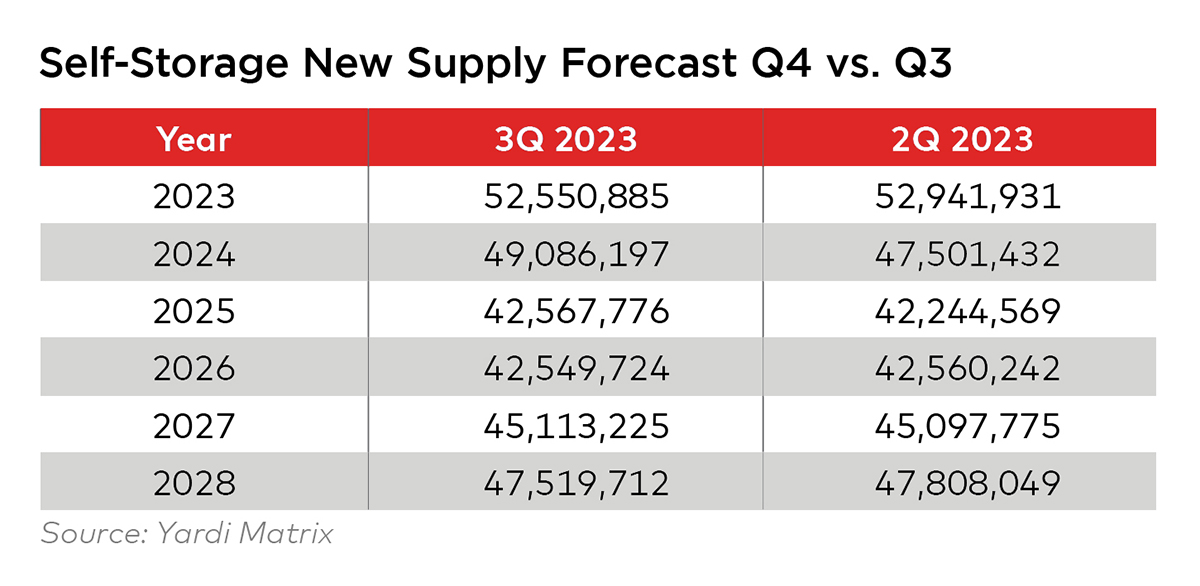
For the first half of 2023, the under-construction pipeline averaged 53.3 million rentable square feet (RSF). In Q3, however, the pipeline expanded modestly to 55.5 million RSF. This represents a 5.5 percent increase quarter over quarter and a 15.7 percent increase year over year. The modest Q3 expansion in the under-construction pipeline is the main rationale behind this forecast update’s increased 2024 supply.
(see Self-Storage Under-Construction Pipeline chart)

Our longer-range forecast anticipates tightening credit conditions will depress new construction activity in the latter half of 2023 and into 2024. How new construction starts evolve is something our entire research team is closely monitoring.
(see Self-Storage Construction Starts chart)

(see Days in Construction chart)

(see Self Storage Planned Pipeline chart)

(see Days in Planned chart)

(see Self-Storage Prospective Pipeline and Abandoned Storage Properties charts)


The forecast continues to assume that a combination of tight financial conditions and a mild downturn in the national economy will depress construction starts in the second half of 2023 through 2024. This will dampen completions in 2025 and 2026, with a rebound taking hold in 2027 and 2028.
Several data points from Q3 2023 suggest the above thesis is beginning to play out. Expansion in both the planned and prospective pipelines has plateaued, days in planned remains at historically high levels, and the number of abandoned projects has increased since mid-year.

ucson is well-known for many marvels. It is surrounded by five mountain ranges and several protected natural areas and contains seven of Earth’s nine ecosystems, making it one of the best destinations in the world for outdoor recreational activities. Now Tucson is also home to an esteemed self-storage facility with breathtaking views of the Catalina foothills and an awe-inspiring design that suspends three stories of units above a creek bed: Arizona Self Storage at Tucson Foothills, Messenger’s 2023 Facility of the Year overall winner.
The award-winning storage facility was developed by Aberdeen Management & Development, led by Founder Chris Monson, President Drew Monson, and Director of Marketing Kim Ryan. Aberdeen has developed many storage facilities over the years in multiple states and manages the Arizona Self Storage brand with facilities throughout Arizona. “We are proud to have worked with the architect, contractor, and landowners to overcome multiple development challenges and ultimately deliver an exceptionally attractive and functional product in which form and function truly complement each other,” says Drew.
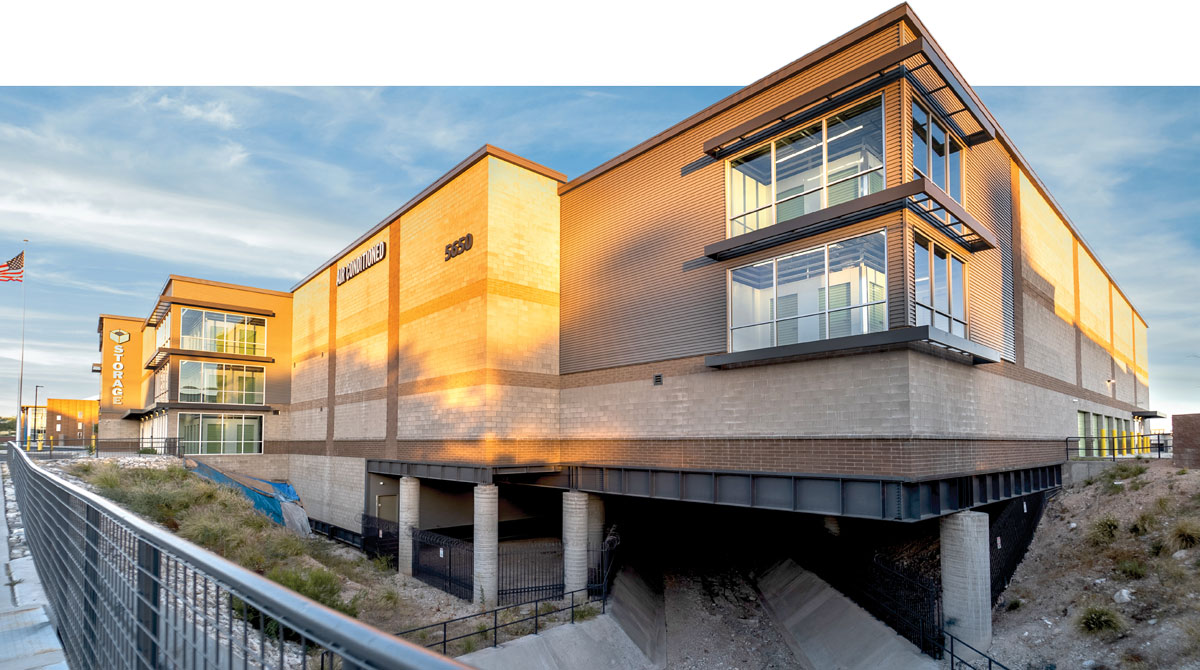
With more than 80 percent of the building’s footprint perched atop hefty beams and four-foot-wide caissons (watertight retaining structures), and stunning “jewel box windows” that resemble balconies to the untrained eye, it’s no surprise that everyone is impressed with Arizona Self Storage’s exquisite exterior and the way it is nestled into the desert topography.
However, because Arizona Self Storage at Tucson Foothills hovers over a “wash” (a dry creek bed that fills with water from monsoons and melted snow from the nearby mountains), taking the facility from conception to completion was no easy task by any measure. On the contrary, it was a momentous feat that required meticulousness and ingenuity from everyone involved with its development.
“From the very beginning of the project, landscaping presented to be an undeniable hurdle,” says Robert Kubicek, CEO, AIA at RKAA Architects, “but one that sets the project apart from other self-storage facilities in an incredible way.”

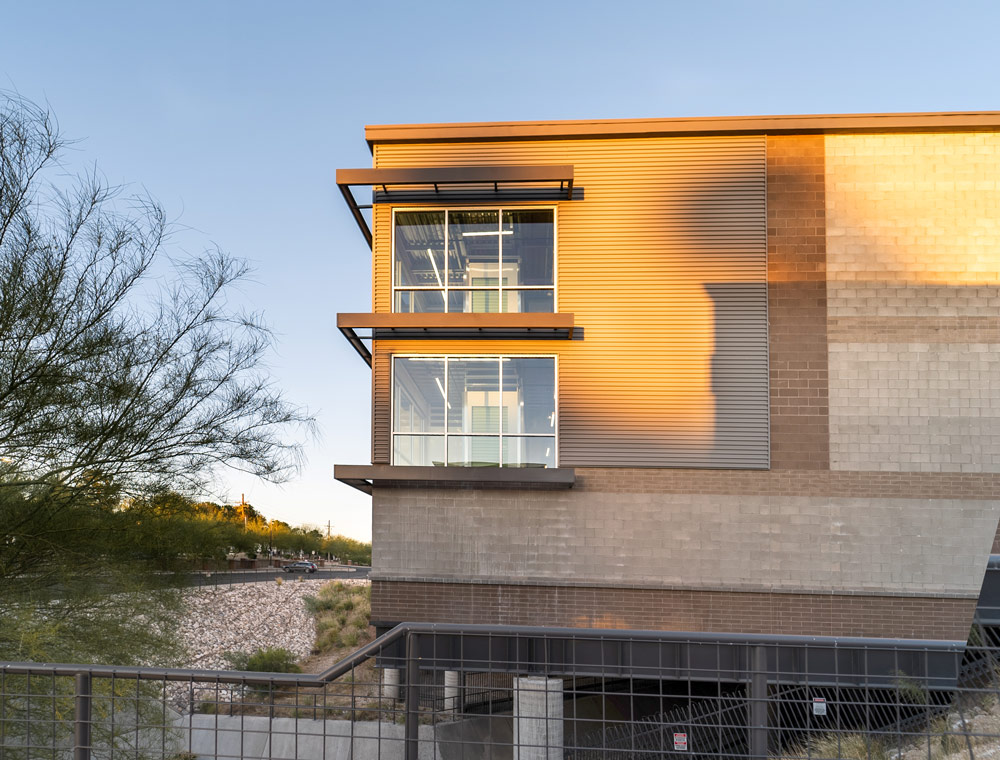

Though they were up for the challenge, the team’s troubles seemed to begin as soon as they made that determination. Protected vegetation within the wash, as well as an aviary for birds, prevented them from making a clear-cut decision about annexing the project into the city. “In the county, you can impact the vegetation in the wash with mitigation,” says Kubicek, “but in the city you cannot.”
They were able to negotiate with the city to keep the county codes, which enabled them to impact the wash’s vegetation with mitigation. They hired Novak Environmental, Inc., a landscape architect, to design a plan and relocate the protected plants and aviary to an off-site location.
“You can say that landscaping was quite literally a foundational piece of this project because if the precise forethought and planning hadn’t occurred, the project would have been prohibited and killed once annexed into the city of Tucson,” says Kubicek.
With that issue resolved, the project was able to proceed to the design phase in 2018, yet it would be about two years until they could break ground. Multiple iterations of the design were necessary to obtain approval from the city, thus delaying the groundbreaking to April of 2020—just in time for COVID-19 to create additional obstacles.
“A week after starting construction, the COVID-19 pandemic was at an all-time high,” Kubicek says, adding that the development was directly impacted by the nationwide supply chain issues, rising costs of materials, and labor shortages. “The team was in uncharted territory and had to combat those unforeseen challenges one day at a time, on top of lockdowns, sickness, and quarantine.”
Unfortunately, selecting alternative building materials was not an option, so they had to spend more on the steel and concrete needed to construct the facility. And since they had to use larger steel beams and cement caissons to hold the load of the building than initially calculated, the extra costs for those materials were substantial.

Had they taken extra core samples in additional locations (and greater depths), they would have discovered that there was more water present in the soil than they believed. Instead, the issue was encountered when they began drilling to pour the caissons, and the team had to redesign the structural plan to account for the excess moisture.
To ensure the structural integrity of the project and “allow for the significant load,” it was necessary to double the size of the caissons and utilize the “largest commercially available beams without going custom,” says Kubicek. For maximum stability, the caissons plunge 30 feet into the ground.
“There is only a small percentage of the building that is actually on grade,” Kubicek says. “The majority of it isn’t on the ground.”
Because of this unique foundation, the four-story facility’s “basement” has a smaller footprint than the rest of the L-shaped building and it isn’t below ground like a typical basement. An access road that connects with a neighboring school and apartment complex enables the basement’s 82 ground-level units to be accessed from the exterior.

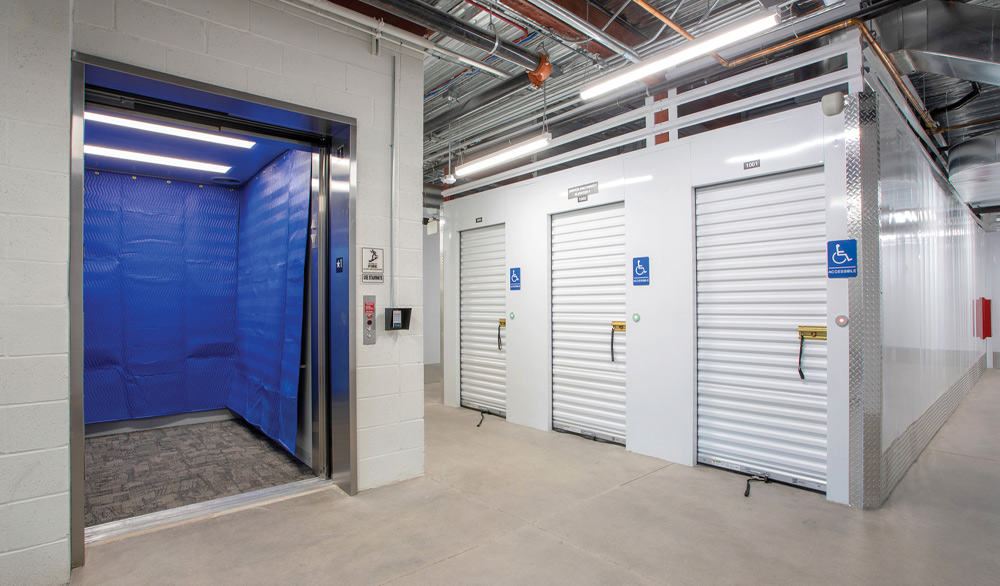
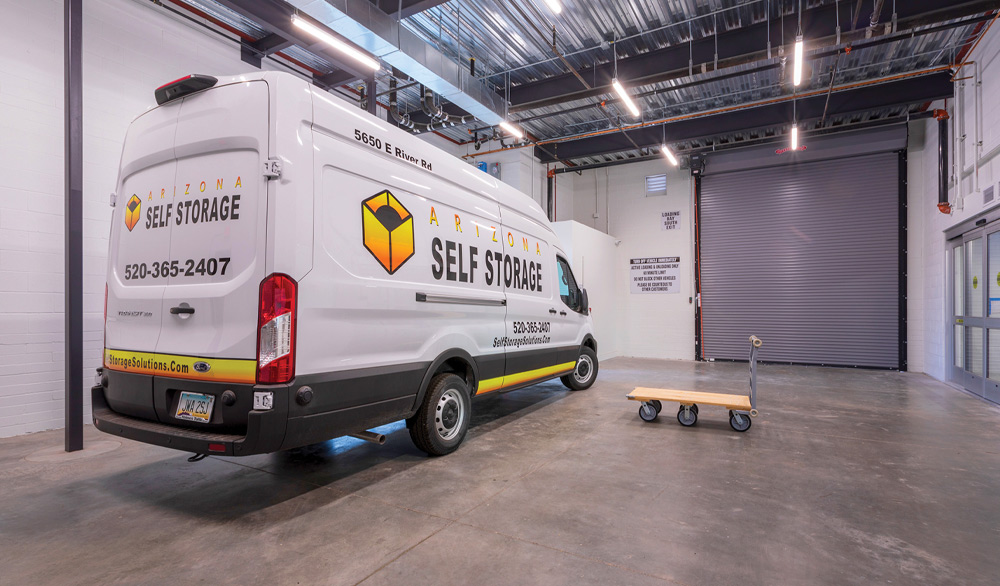
“We hit every bell and whistle to create a first-class customer experience,” says Ryan. “It’s gorgeous and unlike other self-storage facilities.”
For starters, all 678 units, including the drive-up units, are climate controlled to keep customers comfortable as they move their belongings in Arizona’s scorching summer heat. Arizona Self Storage’s drive-thru loading bay is air conditioned as well. “Our customers truly appreciate our unique, fully enclosed and air-conditioned loading bay,” says Ryan. “Once inside, customers are completely protected from the elements as they load and unload their vehicles. People love it!”
The multiple elevators, which service all four floors of the facility, are oversized to allow customers to easily move into their units directly from the protected loading lobby and drive-up access points, with Premium Plus units located nearest the elevators. Standard, Premium, and Premium Plus unit options allow customers to choose the best option to fit their storage needs and budget.
Similar to other modern-day self-storage facilities, Arizona Self Storage has three corners with floor-to-ceiling windowpanes that permit Tucson’s ample sunlight to permeate the premises; the “jewel box windows” also showcase some of the bright green roll-up doors, enabling passersby to identify the building’s purpose. However, unlike other facilities, they aren’t faux doors. “There are real units in those corners,” says Kubicek, who jokes that they should command better rates for their scenic views like hotels do. “They are some of the best views from storage I have ever seen!”
Additionally, awning-like design elements framing the tops and bottoms of the windowpanes give depth to those corners, creating the illusion that they are balconies. As for the rest of façade, CMU in two earth tones and metal stud panels were used to produce bands of color and add to its aesthetic attractiveness.
Within the office and aisles, white hallway systems, polished floors, and quartz countertops keep the facility looking bright and pristine. Diamond plate corner guards, baseboards, and kickplates were utilized to protect the property from damage from their complementary moving carts and dollies.
“Our office is sleek, modern, and fully staffed with an on-site professional management team,” says Ryan. “We sell moving supplies for extra convenience and provide free use of our branded moving truck at move-in. Everything we do is with customer satisfaction in mind.”
Kubicek adds, “No corner was cut in the development of this premier self-storage facility. Quality and customer service are at the forefront of the entire operation.”


“Through the integration of smart technology, Arizona Self Storage takes security to all-new heights,” says Bethany Salmon, product marketing manager of Janus International. “Bluetooth electronic smart locks are installed throughout the facility and allow the specialization in zoning and custom access control per individual tenant. The thorough use of technology allows Arizona Self Storage to enhance the customer experience while taking advantage of operational benefits such as automatic lock checks, overlocks, releases, auctions, thermal motion mapping, and activity mapping. The data mining obtained via Nokē Smart Entry enables the facility to customize its approach and elevate customer satisfaction simultaneously.”
To accommodate each customer’s preference for interactions, Arizona Self Storage offers an online rental and payment system, an on-site rental kiosk, and “top-notch” managers, including an on-site resident manager. “Customers may rent with us in the way they prefer,” says Ryan.
Other perks of the property include extended access hours (seven days a week, 365 days a year), an asphalt parking lot with plenty of parking spaces, and an Arizona Self Storage branded moving truck that customers may use for free to move their belongings into the facility.
“People expect things to be easy and convenient,” Ryan says, “We make storing as easy as it can be!”
ince Arizona Self Storage at Tucson Foothills’ soft opening on May 1, 2022, the facility and its managers have earned high praise from its community members and 45 five-star Google reviews from its customers. It also has a five-star rating on Yelp. Here’s what some of the tenants have to say about the property:
“This facility is gorgeous, recently built, and convenient to navigate … I cannot recommend this place enough!”
“The facility is second to none, and I feel very comfortable leaving a good part of my life in the care of Arizona Self Storage … Highly recommended.”
“Our ‘stuff’ has a nicer view of the city than we do.”
“What a fantastic place! Very clean, great amenities. Very safe feel … Highly recommended.”
“We’ve rented a lot of storage units over the years, and this is by far the best storage unit ever.”
“The facility is well taken care of, clean, and modern. I used to keep my stuff in an ‘outdoor’ storage unit in Arizona. But once I found this place, I’ll never go back to those old, dusty, and hot units!”
“By far the best storage facility I have ever found. High-quality new construction built for safe, secure, climate-controlled storage.”
“AZ Self Storage outshines all storage facilities in Tucson. Clean, modern, and easy to move into.”
Instead of offering heavily discounted move-in rates during lease-up, Arizona Self Storage opted to promote the property through a grassroots marketing campaign that focused on sponsorships of local events such as the rotary club’s classic car show. They also utilized social media and online advertising opportunities through their company website, local listings, Google, Bing, Facebook/Meta, Yelp, and more.
What’s more, in addition to a referral program for existing tenants that provides a $25 discount to the current tenant who refers a new customer, Arizona Self Storage partnered with National Charity League (NCL) to implement a unique referral program that fosters the wellbeing of the community. Each time NCL refers a new customer to rent a unit at the facility, Arizona Self Storage donates $25 to the Tucson Chapter of NCL. According to the charity’s website, “NCL, Inc., Tucson Chapter is a group of mothers and daughters who have come together in a commitment to community service, leadership development, and cultural experiences … Like all NCL, Inc. Chapters, Tucson aims to foster the mother-daughter relationship by serving its communities together.”
“We implemented a multi-channel comprehensive marketing plan that includes online and digital marketing, social media marketing, brand awareness and reputation management, local marketing through signage, partnerships, sponsorships and more,” says Ryan.
Above all, despite being “competitively” priced and not running any move-in specials during lease-up, Arizona Self Storage managed to reach an occupancy rate of 80 percent within its first year of being open.
Operator/Management: Aberdeen Management & Development
Architect: RKAA Architects, Inc.
General Contractor: Canyon Building & Design
Structural Engineer: Simply Structural Inc.
Landscape Architect: Novak Environmental, Inc.
Civil Engineer: Baker and Associates Engineering Inc.
Security Provider: Fortified Security Services
Access Control System: Nokē Smart Entry by Janus International
Management Software System: SiteLink
Roof System Provider: Roofing Southwest, Inc.
Doors and Interior System Provider: Janus International Group
2023 Unmanned Facility Of The Year
StoreEase
Tooele, Utah
By Erica Shatzer

ack in October of 2020, Kelly Gallacher, owner of a facility in Tooele, Utah, managed by StoreEase, toured the StoreEase headquarters and facilities in Birmingham, Ala., to get a feel for its office setup and see its virtual management in action. Although he has been developing self-storage facilities for 35 years (125 facilities spread out over three continents, five countries, and 30 states), he wanted that in-person experience to better understand how to design his own StoreEase facility. Two years and three months later, the ultramodern facility known as StoreEase – Tooele, Utah, which is virtually managed from Birmingham, is generating astonishment from its high-tech features and accolades from everyone who enters its office door.

To that end, Boyd says StoreEase’s virtual management platform “aligns more with the traditional management model” than remote or “unmanned” management systems even though the managers are not physically on site. “It doesn’t have that [unmanned] feel,” he says, because the company’s virtual managers are so attentive, providing fast, friendly service to everyone who enters the office regardless of the time of day. Customers can build rapport with the company’s virtual managers as well thanks to “force ranking” within its software that connects customers with the same virtual managers they’ve communicated with during previous on-site interactions. Per Boyd, five-star Google reviews that mention the virtual managers by name serves as confirmation that relationships are being formed between management and tenants.


On the operational side, self-storage owner-operators like Gallacher are reducing payroll costs and increasing revenue through the StoreEase virtual management platform. “Payroll is $25,000—a fraction of the cost of traditional payroll,” Boyd says, adding that virtual management enables the office to stay open around the clock. “There’s no closing the office or ‘be back soon’ signs.” Extended office hours and a kiosk enable StoreEase – Tooele to capture rentals whenever it’s convenient for customers to rent a unit.
However, it wouldn’t be possible for this facility to be virtually managed without a smart access control system. The Nokē Smart Entry system enables StoreEase’s virtual managers to conduct lock checks, overlock units, automate auctions, and monitor the premises from across the country. The thermal motion sensors notify staff and tenants of unauthorized or suspicious unit activity. With the smart entry system, they have better visibility and control over the site. The Nokē Smart Entry system also elevates the customer experience, providing one-touch entry, the find my unit feature, and digital key sharing. Additionally, StoreEase – Tooele has 26 security cameras linked to StoreEase software that enables staff to view what’s happening on site in real time.



At StoreEase – Tooele, three unit sizes are on display to allow customers to make side-by-side comparisons and determine which unit size will best meet their storage needs. Having demo units located near the rental counter also streamlines the rental process; by not having to walk the property to look at units of various sizes, the amount of time it takes for a customer to make an informed decision is dramatically reduced. “It makes unit selection easier,” adds Boyd.
While other remotely managed self-storage facilities may post regular signage throughout the office to direct customers, StoreEase – Tooele’s kiosk and rental counter screen serve as digital signage. However, unlike a typical sign, the rental counter with screen required a strategic location within the office. It was placed at a specific angle from the front door to enable customers to activate the on-screen greeting and to maximize visibility; its permanent placement permits customers to clearly see the virtual manager on the screen regardless of where they are standing within the rental office. Just like an in-person, on-site manager, virtual managers can walk customers through the entire rental process and show them how to operate the facility’s various technologies, including the Nokē Smart Entry system.
These visual aspects of StoreEase’s virtual management platform have effectively created a simple rental process that all the facility’s customers have openly embraced. According to Gallacher, the mayor and city council members commented on “how easy it is” to complete a rental during the facility’s grand opening. He’s also received nothing but positive feedback from tenants of all ages. For example, one tenant’s nine-year-old niece was able to effortlessly operate the unit’s Nokē smart lock. Even the elderly couple with whom he has spoken is storing with ease, however key fobs are available for anyone without a compatible mobile device to download the Nokē Smart Entry app.
Unfortunately, the first site rendering that Gallacher presented to the city was shot down. He went back to his architect, David Wytmar of Groundwork, Ltd, for revisions, but the second rendering was denied as well.
“It took the team three attempts with the architect to come up with an exterior visual that the city council would support,” says Bethany Salmon, product marketing manager at Janus International. “They decided on a fortress-style building with no exposed doors to the surrounding community. In the end, the mayor and city council members were very impressed with the facility’s beauty and how close to the final product was to the renderings that the team provided.”


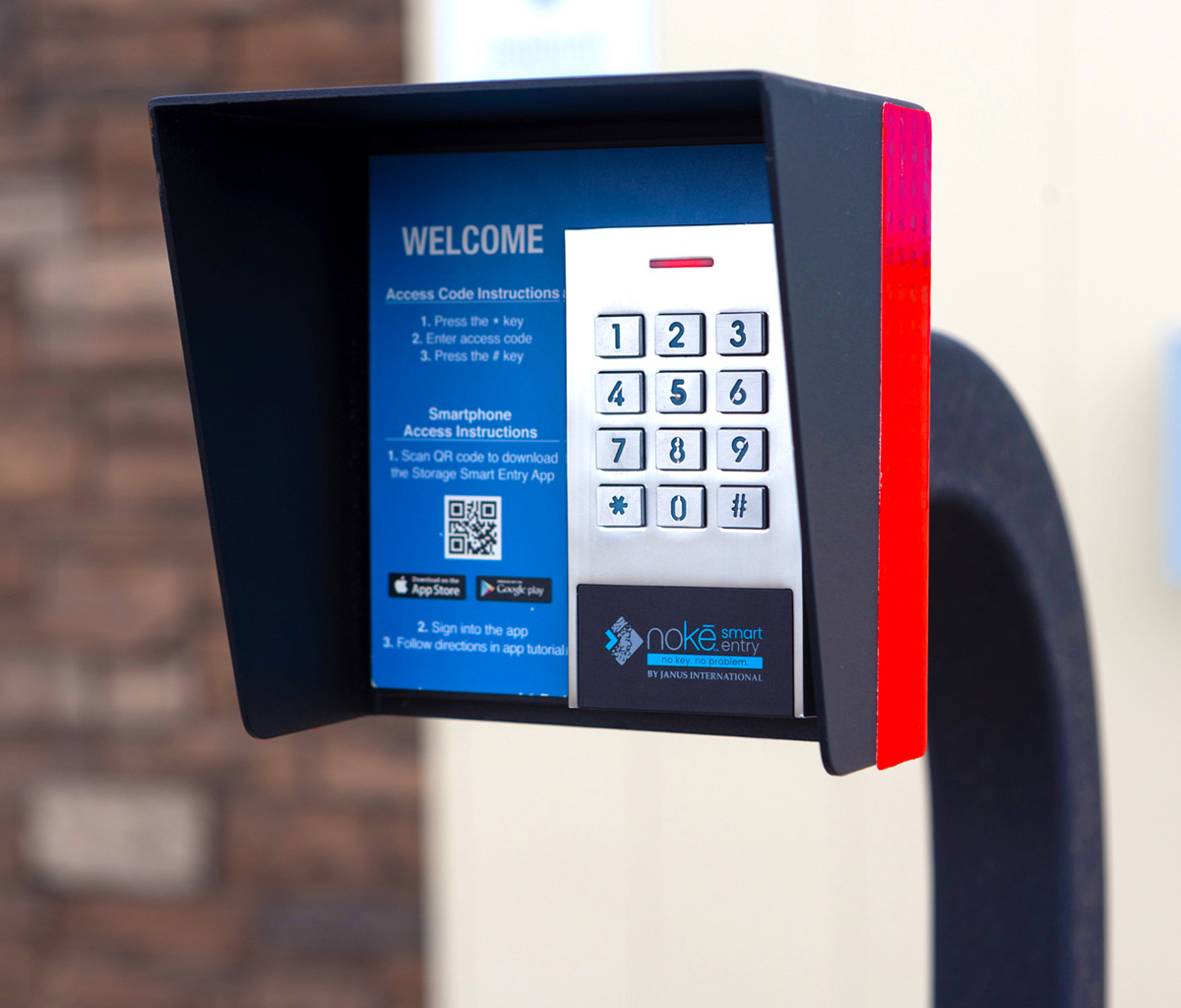

Though Gallacher was initially disappointed with these design setbacks, he’s now pleased that the city pushed for additional changes because he admits that the end result is better than their original vision—an example that has set the standard for other self-storage facilities that may eventually enter the market. It took three meetings over three months for the design to be approved, and Gallacher states that the “lynchpin” for obtaining a green light was the inclusion of trellises that resemble REI stores.
“To further enhance the curb appeal of the self-storage facility, the team wanted to avoid 300 feet of boring metal panels,” adds Salmon. “By incorporating intricate trellises, faux stone, and faux windows … they were able to create a beautiful presentation without an abusive cost.”
Expanding on Salmon’s description, Gallacher explains that the faux windows at the office’s storefront entrance are merely a reflective metal that creates the appearance of windows—a feature supplied by Janus. He also mentions that StoreEase – Tooele may be the first self-storage facility to utilize Janus International for all of its storage products: security and door entry (Nokē Smart Entry), roofing and structural (BETCO), and doors/interior systems. “They are the dream team,” he says.

“The first obstacle involved the property being adjacent to an intersection that didn’t have access to the southernmost boundary road,” says Salmon. “The Utah Department of Transportation had the road access closed off.”
Per Gallacher, the land also has a stream bed that he decided to purchase and maintain so the parcel continues to attract wildlife. “We had a company come in to do the landscaping while keeping a very natural approach and optimizing the land’s existing beauty,” Salmon says. “The city was kind enough to allow us extra time for natural growth to occur, so we could wait for trees and bushes to mature naturally.”
In regard to zoning, the plot was considered a “split zone;” half of it was zoned for commercial use and the other half was zoned for industrial use. The commercial half of the site needed to be rezoned, which tacked another nine months onto the process.
Once it was properly zoned and all the approvals were obtained, construction of the primarily concrete and metal facility could commence. However, material shortages required Gallacher and the construction crews to pour slabs and build one building at a time.
“With the robust development in the community, there was a large demand for concrete and the local companies were divvying out how much they’d allow customers to have,” says Salmon. “To avoid mobilization fees, we reprioritized projects and found ways to stay busy and boost productivity.”
This approach was possible because Gallacher had pre-purchased all the steel required for the project to avoid potential price hikes and supply chain issues. “I saved $800,00 to $900,000 by pre-purchasing the steel,” he says.
To meet city requirements and customer expectations, StoreEase – Tooele consists of 13 separate single-story buildings. “The city would only allow single-story buildings,” Gallacher says, “and there are no multistory facilities in the area. The customer base is used to drive-up.”
In total, StoreEase – Tooele has 85,000 square feet and offers 580 units. One building (approximately 9,000 square feet) has climate-controlled storage space. Since their market study found 5-by-5 units on end caps to be unsuccessful in their area, the team decided to utilize larger (10-by-10s, 10-by-20s, and 10-by-30s) units with two or three doors as end caps. “They were the first ones rented,” says Gallacher. They charge a premium for those special endcap units, but customers who pack their units to the gills appreciate having additional doors to easily access their belongings.
Along with those public relations efforts, its social media presence and Google My Business listing have enabled StoreEase – Tooele to reach an occupancy rate of 30 percent since opening in January. While lease-up is off to a slower start than anticipated, due to the interest rates that have hampered home sales, Gallacher still expects the facility to be stabilized within 14 months. “There’s a lot of development going on in Tooele and around the property,” he says, adding that he’s confident in the facility and its prime position within the city. “Storage operators are wanting to buy the property because it has high visibility on the main street.”
Though flattered by the offers, Gallacher has no intentions of selling his award-winning self-storage facility anytime soon!
Management Company: StoreEase Virtual Management
Developer: Gallacher Development LLC
Architect: David Wytmar of Groundwork, Ltd
Security and Door Access Provider: Nokē Smart Entry by Janus International
Management Software System: StorEDGE
Roof/Structure: BETCO Inc. and installed by Johnson Construction
Doors and Interior Systems: Janus International
Baltimore, Md.
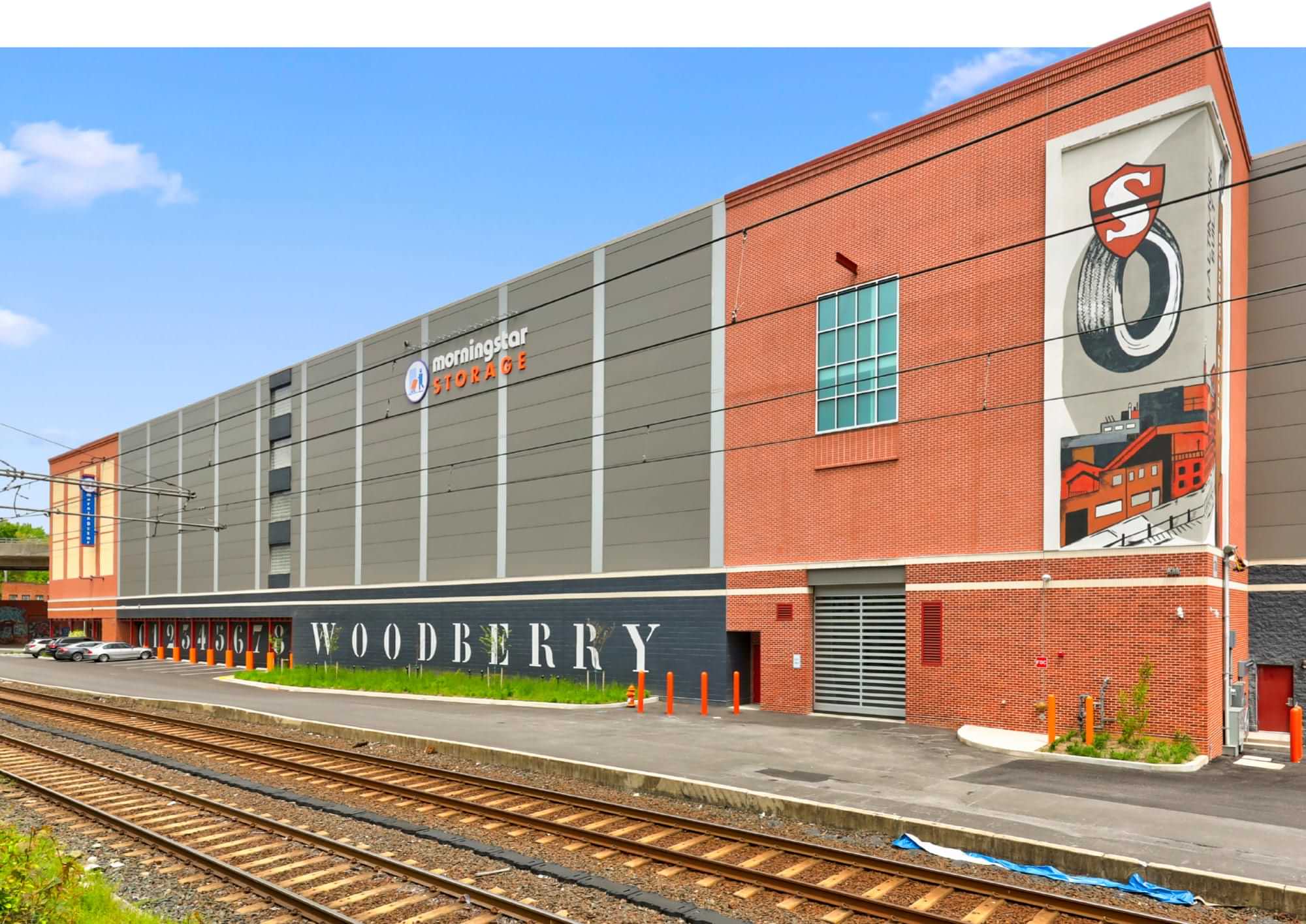
orningstar Storage took on an unusual construction challenge when it decided to develop its Union Avenue self-storage facility on the site of the former Schenuit Rubber Tire factory building in Baltimore.
Modern Storage Media took notice and gave the facility its 2023 Facility of the Year award for the construction category. Many elements of the project prompted the publication to give the facility the award.
Because of the former building’s historical significance in the city, Morningstar worked with the Woodberry Community Association and Baltimore Heritage to create a museum inside the new facility’s office with artifacts from and photos of the building and grounds when Schenuit operated there, according to the company’s written application for consideration for the award, including a few tires manufactured at the plant.
A mural on the outside of the building, visible to passing light rail commuters, “serves as a reminder of the site’s historical significance, encapsulating the facility’s dedication to preserving and celebrating the heritage of the area it proudly serves,” the application states.
The former factory building, a past emblem of Baltimore’s industrial strength, had fallen into disrepair and was condemned. As the start of work neared, part of the building collapsed and fell to the tracks of the transit system below. Asbestos was discovered and had to be remediated.
Another obstacle arose after the company got approval to turn on power for the facility: No transformers were available, related to COVID-19 supply chain disruptions, he says. They had to shut down the building for three months.
Separately from these problems was that the company had to shore up the site by bringing infill material to prepare the ground to support the new building’s load, Heise says. The building cantilevers over the Jones Falls stream. The area is also prone to flooding. A retaining wall was built “to accommodate rising river levels without issues.”

Morningstar bought the site with plans already in place, he says. It was a unique design for the company. They typically use more precast concrete. The company developed the project as a joint venture with developer Klein Enterprises of Baltimore.
The Union Avenue facility blends materials including insulated metal panels, stucco, and brick. It incorporates a lot of steel, concrete, and X-bracing to transfer the load back to the foundation, Heise says. The building is rated LEED Silver and has solar panels on the roof. It’s the company’s first facility with ground-up solar. It also has a remote monitoring and control system for its HVAC system, which he thinks is unique for a storage facility.
Chesapeake Construction Group of Ownings Mills, Md., was the project’s builder. Michael Shevitz, the company’s senior project manager, oversaw the project.
Shevitz says one of the main reasons he thinks the project won MSM’s award is because of the degree of difficulty in preparing the site to build based on its location and the ground’s condition.
One side of the building runs closely alongside the Jones Falls Expressway and the Jones Falls stream underneath it. Another side of the building fronts the 14th Street Bridge. And a third side runs along the light rail system.
Chesapeake ended up changing contractors to demolish the building, saving the owner $1 million.



Drivers on Route 83 running past the facility are “very close to it, so it really stands out,” he says.



- Participation in the mayor’s Christmas parade in Hampden. The team rode the parade route and distributed information and candy to hundreds of people in an effort to boost excitement and awareness of the new facility in the community.
- Strategic billboard placement near the facility before its opening to advertise the facility for local residents and commuters.
- The management team engaged with the community by placing door hangers throughout the city. They also connected with local businesses and apartment complexes to generate referrals.
- The team distributed Morningstar-branded coasters to local bars and advertised on Ribaldi’s Pizza boxes to spread visibility in the neighborhood. And they provided bags at a neighborhood farmers market to support local events.
- The team connected with the Baltimore Chamber of Commerce and hosted a Maryland Business Exchange networking meeting at the facility.
- Morningstar Storage offers customers free use of its branded moving truck, which serves as a mobile billboard as well as an amenity.
- A reader board incorporated into the facility’s branded monument sign is used to display fun messages and keep the community interacting with its social media posts.
- The company also has a program called Morningstar Cares. Through the program, the company encourages each of its storage facilities to donate 5 percent of its units to local nonprofit organizations for their storage and office needs.
The Union Avenue facility currently partners with the following organizations:
- Kennedy Krieger
- Restoration House Women’s Charity
- The Red Cross
- Baltimore Community Food
- Saint Mary’s Outreach Center
- VFW Post 2
- Rescue Mission Inc.
- Sharebaby
- Baltimore Chamber of Commerce

In addition to its numerous community outreach efforts and unique marketing tactics, Morningstar Storage prominently advertises its promotional special (two months of free storage) to attract new tenants. The facility has the concession boldly displayed on a billboard along the interstate, at an intersection, and near a busy shopping center. The company’s bright blue and orange brand colors make its message highly visible to passersby.



“These guys are new. The place was incredibly clean, the prices are fantastic, and they have some cool things I’ve never seen before. For one thing, you drive into the middle of the building to load and unload, meaning your move-in or out is not in the elements! They also have a van they will loan you at no charge as long as you reserve it in advance. It’s a whole other level of service for that industry.”—John Coulson
“Recently after losing our house to a fire, Morningstar Storage helped us in so many ways. Not only did the manager, Adam, go out of his way the day we immediately needed them by donating boxes for moving but also organized a donation of clothes and housing items for all the people affected in the weeks after! The facility itself is new, clean, and safe. It has a large area to load and unload your things and carts always available.”—Jennifer Surette
Rentable square footage: 108,025
Number of units: 1,054
Occupancy as of Dec. 1, 2023: 42 percent
Owner: Morningstar Storage, a unit of Morningstar Properties of Charlotte, N.C.
Builder: Chesapeake Construction Group
Architect: Remus Architecture
Management software: SiteLink
Security system: HS Tech Group
Roof: Rosedale Roofing
Doors and interior systems: Janus International
Solar: Lumina Solar
Knoxville, Tenn.

he owners of Valley Storage in Knoxville, Tenn., spared no expense in offering a visually appealing, upscale storage facility in an underserved market where demand is high. Located in Knoxville’s Hardin Valley technology corridor, Valley Storage was designed to meet customers’ needs today while saving on operational costs in the future. The facility is not only aesthetically pleasing, but it also excels in functionality and energy efficiency.
With 60,650 square feet of climate-controlled self-storage, spacious units, and auto, boat, and RV spaces, the facility will serve the needs of greater Knoxville for years to come. Commercial deliveries and large-scale residential moves are easy with Valley Storage’s convenient tractor-trailer access to the facility.
The 85,000-gross-square-foot facility offers 591 units and a spacious office as well as 38 outdoor parking spaces. The site is professionally managed by Atlanta-based Universal Storage Group (USG) and offers an array of amenities to its customers, including a self-serve coffee bar, complimentary cold bottled water, fresh cookies, and free Wi-Fi throughout the premises.
Winslett, who has worked in the metal building supply industry, has been erecting self-storage for 14 years. Having seen many versions of how self-storage can be built, he had definite features in mind. “I have a unique perspective because I build so many types and styles,” Winslett says. His focal points were energy efficiency and high-quality finishes.
Winslett and Dee previously worked together building Dee’s first facility, which was completed in 2022. Along with two additional owners, this is the first facility they have owned together. Dee’s background is in landscaping and residential construction. He owns a multifamily property but has long been interested in storage.
“Several years ago, I started calling around to self-storage facilities to find some space in my local area,” Dee says. “I was shocked that these facilities that had 60,000 to 80,000 square feet didn’t have any units available.” He also realized he could get the same rent per square foot he was earning on his multifamily property. After finishing the first facility in April 2022, he was anxious to start again. His team broke ground on Valley Storage a few months later in July.



Dee’s crew skillfully took on the grading, excavation, slab preparation, underground utilities installation, and landscaping. The addition of a well that services the facility and provides irrigation for landscaping was another cost-saving feature.
The 4.5-acre site Dee chose had been listed for sale for some time, but he initially passed over it. “I had a limit on the price of land,” Dee says. “It felt like more money than I wanted to spend, so I hadn’t considered this site before.” Located on prime land in the technology corridor, Dee later reconsidered. “There were already utilities on the site and access to the road we’re on,” he says. “After accounting for those things, I realized this was actually the same money we had spent on the first facility.”
Dee says permitting was relatively easy, as Knox County is not difficult to work with. With an initial feasibility study completed by USG and the site selected, he secured a loan with the bank that had financed the first facility and quickly moved forward.
“You can’t build a building on topsoil,” Winslett says. “It was a hiccup, but we did it ourselves and got it out of there pretty quickly.” Dee’s crew removed the dirt, and he invested in a soil-filtering machine, which has allowed them to stockpile topsoil to sell to other contractors in the future.
Dee and Winslett were determined to leverage the property’s natural terrain and adopt a bi-level concept. In essence, both levels have “ground-level” access. Customers can access the lower level with a driveway that has a slight grade. This resulted in substantial cost savings as it eliminated the need for elevators.
Winslett was particularly eager to incorporate some superior products he had worked with that would ensure maximum energy efficiency and low maintenance. First was a specialty roofing system that features a PBR/metal deck ceiling. “We put an R-panel deck in the roof, then three inches of spray foam insulation, and then a layer of Sag-N-Bag,” Winslett says. “Then, we ran a continuous run roof panel with no mechanical laps. If there were to be a leak in the roof, it’s going to get stopped by that metal system.”
In addition, he used Superior Walls for the foundation walls, which are prefabricated concrete walls that are damp-proof and fully insulated. “It’s a thin sheet of metal on the inside and outside, sandwiching four inches of foam,” Winslett says. “It looks aesthetically pleasing and is superior when it comes to sound and R value. Our energy efficiency in that building is remarkable. Our first couple of power bills to run an 82,000-foot, climate- controlled facility were less than my power bills for my home.”
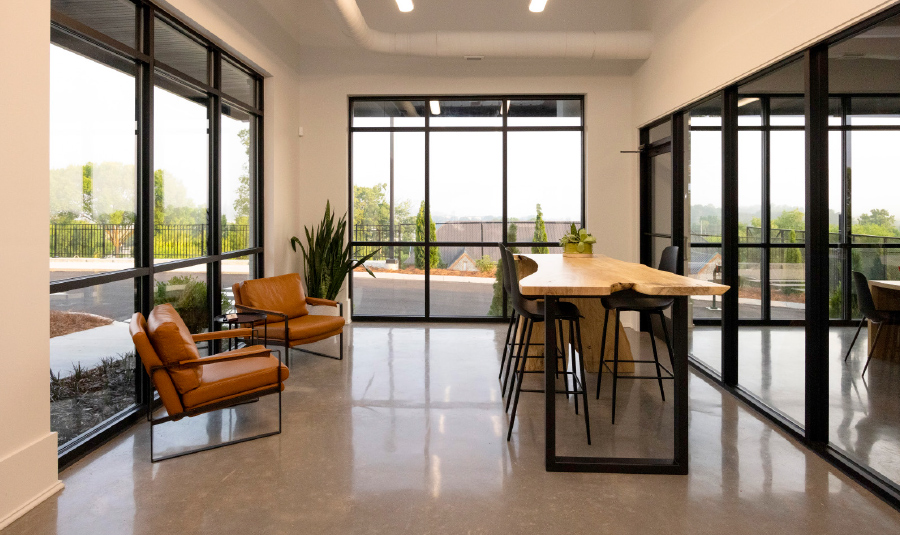


Winslett estimates it would typically cost 30 percent to 40 percent more for these exterior wall panels, and maybe 20 percent more for this type of roof. He expects that energy savings will pay for the extra costs within five years. Another energy-saving feature Winslett included is reflective glass in the large office windows. “I noticed over the years that people often had to put a secondary film over the windows to keep the heat out,” he says. “It was better to do this up front.”
In spite of its energy-saving features, the most important objective for Dee and Winslett in designing Valley Storage was to create a customer-focused design. The entire property is well-lit and monitored for security. In addition, each loading door features a large canopy so customers can load and unload out of the weather. A spacious parking area makes backing in easy, and even at busy times, there is ample room. The facility has accommodated as many as five moving trucks at one time.
Acting as their own general contractors meant that Dee and Winslett could build the facility at their own pace. “We maintained full control over every aspect, including finances and the timeline,” Dee says. “We completed the 85,000-gross-square-foot facility in just nine months—a monumental achievement in securing our certificate of occupancy.”
In line with the design criteria, the focus was on selecting upscale, high-tech, and sturdy elements that harmonize with the continually evolving surroundings of Knoxville. This led to the choice of neutral interior and exterior color schemes that are timeless and sophisticated. The office furniture was meticulously handpicked to align with the upscale aesthetic.

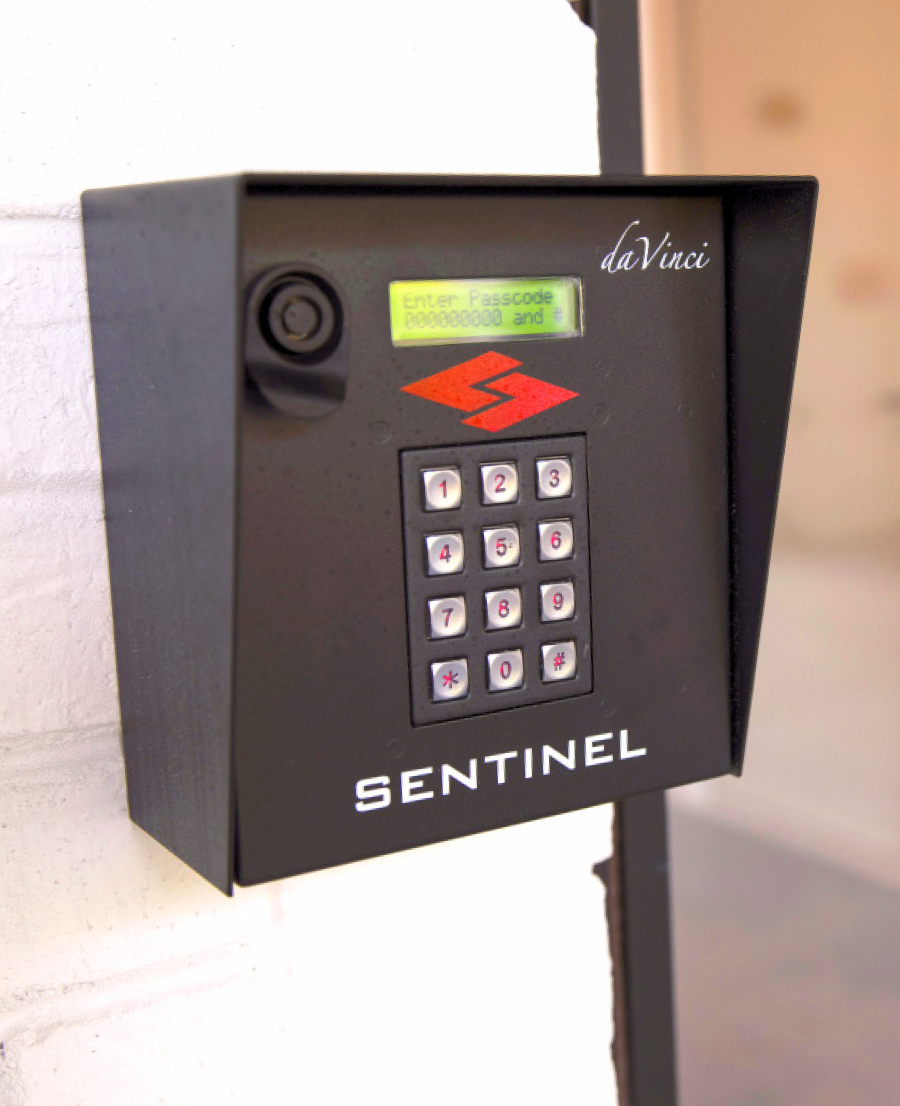
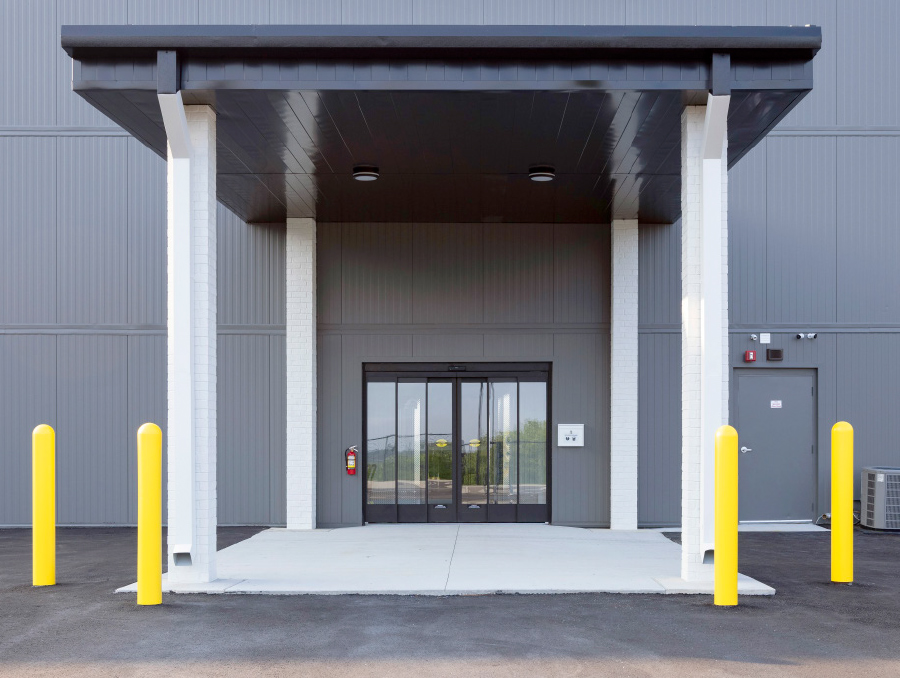

USG’s property manager, Dena Green, notes that it’s a great convenience for customers that there are restrooms on both levels. “A lot of facilities don’t have that,” Green says, “so you would have to leave the facility to go to gas station or somewhere.” Another convenience is that customers can rent online and receive both an access code to the Sentinel keypad and a code for the DaVinci lock on their unit.
Green believes the spacious, upscale office sets Valley Storage apart from competitors and makes it a great place to work. “I love sitting in the office and looking out the window,” she says. “The mountain view is absolutely beautiful.” The space also includes a retail area that offers residential and business customers a comprehensive range of moving and packing supplies.

Lease-up on the new property has been steady, and the owners report that it is 50 percent over projections. “A lot of people are moving to Knoxville,” Green says. Hardin Valley is seeing rapid growth and a constant influx of new businesses, apartments, and condos. “It’s growing big, and it’s growing quick,” she says.
Dee and Winslett say that the project has transformed into what they envisioned: an incredibly spacious, convenient, secure, and dependable storage facility catering to the needs of the local community. “From its captivating visual appeal to the integration of various energy-efficient elements, we are extremely proud of the favorable results we achieved through our dedicated efforts,” Winslett says.
Green says the success of the property is largely a result of the time and care that went into its design and construction. “There was a lot of thought and care put into the building of this property,” she says, “and they are always looking to make improvements.”
General Contractor: Greg Dee and Scott Winslett
Design/Engineer: Mark Kawczynski, PE
Builder: Four Seasons Contracting, LLC
Accounting System: SiteLink/Storable
Access Control/Security System: Sentinel Systems
Doors/Units: ProSteel Buildings
Management Company: Universal Storage Group
Office Layout and Finish Materials: M. Anne Ballard of Universal Storage Group
Branding and Logo Design: Stacie Maxwell, Universal Storage Group
Tyler, Texas

n the seemingly endless evolution of technology, the limelight shines the brightest on the “smart” category. But what exactly is smart technology? Williams College’s Office for Information Technology defines smart technology as “the integration of computing and telecommunication technology into other technologies that did not previously have such capabilities. What makes a technology ‘smart’ is its ability to communicate and work with other networked technologies, and through this ability to allow automated or adaptive functionality as well as remote accessibility or operation from anywhere.”
That “operation from anywhere” element hits self-storage where it lives as more operators are building facilities they can manage either partly or fully remotely.
Superior Storage’s latest of three facilities in Tyler, Texas, fits that description. The company built all five of its facilities with smart technology “from the bottom up,” says Adam Wagner, co-owner with Chris Chitwood of Superior’s latest Tyler facility, which is its first with boat and RV storage included. It won Modern Storage Media’s “Smart Facility of the Year Award” for 2023. Superior has another facility under construction and is planning several others.
Wagner says the company’s award-winning facility, referred to in-house as Tyler West, is among the only facilities he knows of that operate completely with technology, including its camera systems, the Nokē technology that gives tenants access to automatic doors on select boat and RV units, and its gate system. Its remote concierge manager (RCM) software enables completely remote, integrated property management.
“When a tenant comes into the office, it triggers motion,” he says. “We answer the motion from our corporate office in Longview, and we can walk that tenant all the way through the whole property, never losing that face-to-face connection. Whether it’s on the kiosk in the office or we transfer that video call to that tenant’s smart device, we thought of a way to do storage that’s outside of the norm and decided to integrate it all the way through.”

“The thesis of our company is we’d much rather run 100 percent remote with highly trained people in our corporate office that would then answer and manage those properties remotely,” he says. “We went from a thought process of, ‘We think this would be great’ to ‘Let’s dive all the way into the deep end and solve the issues as they come up, not just dip our toes to see if technology works.'”
Superior does face challenges, mainly when the technology doesn’t work as designed, Wagner says. Systems must have processes in place to solve those problems when they arise. The company developed a checklist to monitor and respond to such problems.
One of the biggest technological problems the industry faces is fragmentation, he says. A facility operator could have some technology components such as Nokē, cameras, and a security alarm system, but none of them is integrated with the others. Superior chose to partner with Tenant Inc. because its management software enables Superior to integrate these technologies and thereby better serve its customers.
“Technology can sometimes be very stale, like when you have a remote-managed property,” Wagner says. “It can seem sterile or not inviting. So, we try to jump over that hurdle. We try to be personable.”
Superior’s property managers visit their facilities in person to help them when they remotely direct tenants inside the facilities. The managers also keep schematics of the facilities on hand for reference.
“We can track the customer through the whole property,” Wagner says.
Superior’s prospective customers typically sign a rental contract within 15 minutes of walking into the facility, he says. He thinks that’s why they won MSM’s smart facility award, because they “cracked the code of how we can do this.” The company also has a contractor who comes to the site to address problems when they arise and walks through the property weekly.
The technology Superior uses is constantly evolving and has improved in the past several years, Wagner says. This includes cameras and property management systems.
“Things have gotten a whole lot smarter and faster,” he says. “Our core belief is a lot of times older-school facility owners don’t believe in remote storage management. We go out and find a solution if something doesn’t work.”
Wagner thinks the way Superior uses technology will become the norm in self-storage. Younger people are the largest generation using storage. They are familiar with using technology and not interacting with people to get services. They use technology in every aspect of their lives. He wants “to learn how to meet my customers where they’re already transacting.”
Tenant Inc.’s management software enables Superior to make that meeting with its customers happen in ways they’re accustomed to.
Tenant CEO Lance Watkins says the key distinction between its property management system and its competitors’ systems is that Tenant’s is built entirely as a vertically integrated software as a service (VSAS). Most other systems are “horizontally built,” meaning they function independently of one another instead of being integrated into one system.



Tenant Inc. started in software more than 10 years ago on the consumer side for e-commerce. “We were inventing things as basic today as renting storage units online,” Watkins says. “Before COVID, not a single company could rent storage online. As we continued to build to the end user, we continued to find challenges with lack of integration. Data was slow and much of it incompatible. Those systems were designed in an era when doing business online wasn’t even considered, wasn’t a reality. So, we designed them.”
Tenant had been building tools to conduct business online. The idea of remote management of self-storage “was already in our wheelhouse,” Watkins says. “The smart storage facilities that are out there now, like Adam Wagner’s, were trying to accomplish a lot of things for the customer where the storage manager may or may not be present. I like to think of our software being reverse compatible, meaning that traditional software stacks may serve the customer well if there’s a person there to operate them. But if there’s not a person there to operate them, they collapse with a lot of deficiencies. If you can serve the customer efficiently without a person there, you can also reverse to, obviously, if you’re staffed.”
Wagner is on the cutting edge of using remote management in self-storage and “taking it to another level,” Watkins says. Several other operators are also doing that. And now some of the big REITs are, too. He has stores that close the office two days a week. An efficient remote-management system allows that. Tenant had tackled many issues for years that enabled it to find greater efficiency for running facilities fully remotely. One of the things the company does that others don’t is build tools that help remote managers cycle through their facilities to manage delinquencies.




A tool like Storage Treasures makes remote management much easier, according to Watkins. The company also unifies all forms of communications with its customers in a cloud-based system. This integration helps with auditing a customer, for example. Having all this information in one place is crucial if you’re managing properties remotely.
Talent uses the Hummingbird property software system. It uses Mariposa for the consumer interface, and it uses a “data orchestrator” called Nectar. All of them are fully integrated.
Smart storage operators “are flocking to us,” Watkins says, largely because of the Nectar system. “It almost feels casual, having a conversation as you move through the space. We encourage these types of new methods and systems. What’s different about Tenant is we designed it from the ground up to help them innovate. Newer operators have ideas and need to integrate. We give them that access and they go to town and stand up their proof of concepts and succeed quickly or pivot when they fail.”
Watkins describes a large self-storage operator that wanted to use digital wayfinding maps. It’s good technology. The operator spent a year and a half integrating it with its systems but was dissatisfied with the technology. The company contacted Tenant, which got the system up and running within two days.
“That is a massive differentiator,” Watkins says. “For smart stores, wayfinding works its way into those systems. Not just for customers by providing good physical signage. But those tools make operations more efficient, maintenance, delinquent spaces. Maybe checking space after a customer moves out. You need good quick tools to do that. Our system gives the ability to do those kinds of things, manage your staff who’s communicating with the customer and goes to facility.”

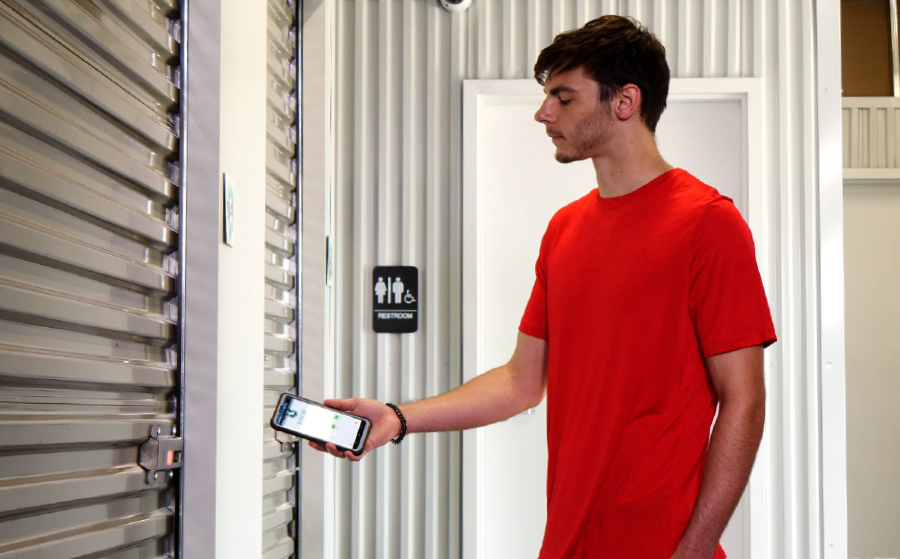
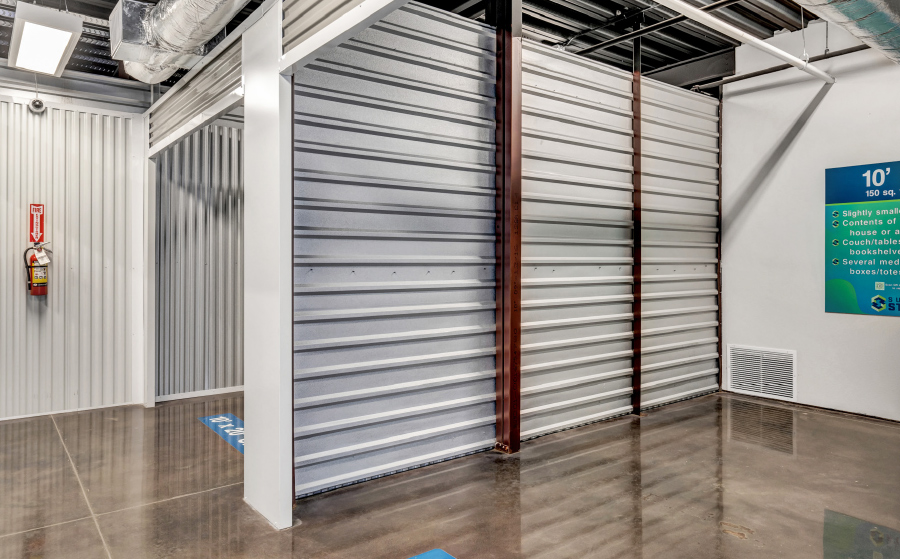
Despite the importance of in-person customer service, “there are no great brands or services in America now that aren’t tech driven,” he says. “If you are a really good brand in today’s world, there’s a significant tech element.”
Self-storage has kept a low public profile for years, Watkins says, but that has changed because of the industry’s recession-resistant strength. Self-storage is “a need-based commodity, and you have to be super-efficient with a commodity to outperform the competition.”
“We’re also more retail, moving people in and out every day,” he says. “The public storage companies are waking up now to tech.”
Overall certificate of occupancy: Sept. 15, 2023
Net rentable square footage: 145,438
Number of units: 798
Co-Owners: Adam Wagner and Chris Chitwood
Builder: Trademark Construction LLC
Architect: Dallenbach Cole Architecture
Management software: Tenant Inc.
Security system: Nokē Smart Entry by Janus International
Roof: MakoRabco
Door and interior systems: Janus International

onstructing self-storage in different countries is a challenge, but Mr.[B]’s Self Storage makes it look easy. Frederico Rolz, CEO, finds the process exhilarating and rewarding. Mr.[B] Self Storage continues to excel at not only acquiring land and navigating the permitting process in different countries, but also educating new areas about the benefits of self-storage.
Mr.[B]’s Curridabat Costa Rica won the International Facility of the Year, the second consecutive year the company claimed the title. Last year, Mr.[B] Self Storage won International Facility of the Year for Lope de Vega in the Dominican Republic.
Mr.[B] Curridabat is a modern building constructed to conform to the surrounding residential neighborhood. It has 52,926 rentable square feet and offers 519 units.
![aerial view of Mr.[B] Self Storage](https://digital.modernstoragemedia.com/assets/2024/01/mr-b-intl-2-e1704389162440.jpg)
The market analyst didn’t give the partners good news. “They told us ‘No,’ it wouldn’t be a good idea,” recalls Rolz. “We were adamant and went ahead anyway.” The company chose to begin the business in Guatemala City, the largest city in central America.
Their idea, which also included educating most government officials and the public about self-storage, led the company to expand to El Salvador in the early 2000s and Costa Rica in 2015. “We needed to view our company as a regional company to expand into the rest of Central America,” says Rolz.
Per Rolz, there is a prime market for the self-storage industry in central America, which is strategically positioned between North and South America and links the Atlantic and Pacific Oceans through the Panama Canal. The region is comprised of seven small countries: Guatemala, Costa Rica, Belize, El Salvador, Honduras, Nicaragua, and Panama. Because the countries have a combined population of 48 million, which is larger than the state of California, and a GDP of 250 billion, which is comparable to South Carolina’s GDP, Rolz says it makes the region more than adequate for developing self-storage.



When Mr.[B]’s decided to expand into the Dominican Republic several years ago, they knew there would be some cultural differences. However, although all the countries in which it operates share the same base Spanish language, there are local and regional interpretations. “Mr. Bodeguitas is understood as a pub,” laughed Rolz. “So, we had to rebrand the company as Mr.[B] to avoid confusion.”
The rebranding effort was completed in 2020.
The research determined the best possible location would be in the eastern part of the city. The search for land began in 2018. Rolz and his company thought they found the perfect plot. “Unfortunately, the deal couldn’t be closed, as a representative of the owner had signing authority but couldn’t close the deal, as the registered owner died without a will,” says Rolz.


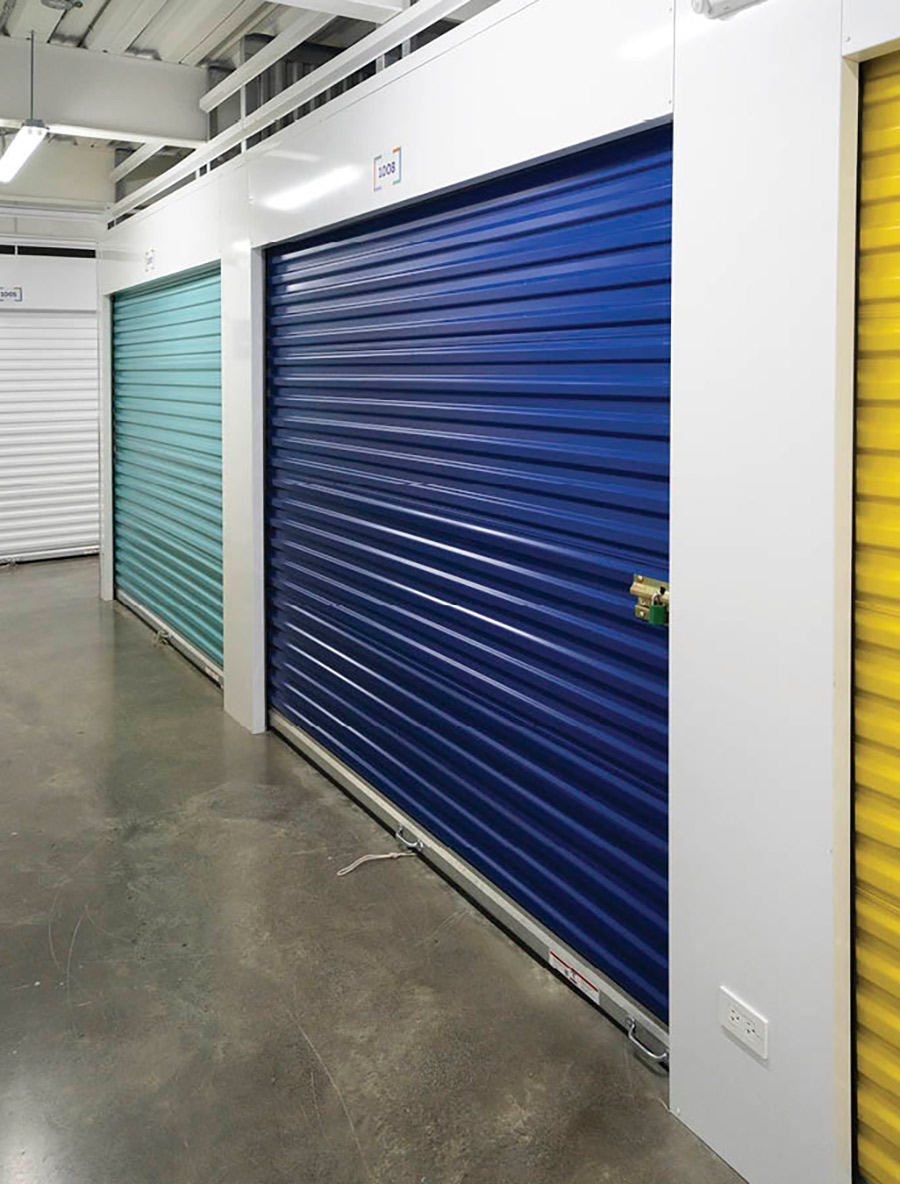

Rolz recalls two sisters owned the land. The sisters and a nephew had signing power to sell the land, but the nephew’s brother stepped in after the acquisition, filing a lawsuit to void the transaction. After eight months of legal wrangling, the courts ruled in the sisters’ and Mr.[B]’s favor, clearing the way for development.
However, by the end of 2019, tax laws had changed significantly, further delaying the process; then 2020 and the COVID-19 Pandemic hit the world.
The original design was submitted with the Mr. Bodeguitas colors and design, so they had to be changed with the new brand colors. However, the interior and structural components weren’t changing, so Rolz and his team understood they wouldn’t have to submit a new design to the municipality.
“One of the neighbors went to the mayor and filed a complaint about the architecture,” says Rolz. “He didn’t want to see a metal box in the neighborhood.” The complaint initiated a new negotiation with the municipality. “Afraid of the neighbor’s complaint, they asked us to do a redesign adding as many windows as possible.”
Orlando Gei, whose company, ESTRUconsult, provided the architectural and structural engineering design, says they have been working with Mr.[B]’s for several years. “We know well what they want for their projects, but this one is in the middle of a residential area and the municipality wanted to increase the number of windows,” says Gei. “Most of the projects have the windows in the corridors, but some of them were placed in the storage areas.”
Gei and his team were able to create a design acceptable to the municipality, but these changes resulted in a cost overrun and delays in beginning construction.
The delays also created new challenges as construction was commencing during the beginning of the rainy season in February 2022. The first step was to demolish an existing house that sat on the property.

The soil challenges are typical for the country, Gei says, but this project required 35 of the tiers, which is also referred to as a “deep soil solution.”
The soil, combined with the fact it was the rainy season, caused the ground on part of a neighboring property to sink in, which in turn caused a wall to partially collapse. The most renowned geotechnical engineer in the country was called in to help mitigate the issue. He advised to build an anchored wall and a self-nailing wall at the side of the street. “These foundations were a challenge within a challenge,” says Rolz. “We typically build the foundations and then everything above it, but never from top to bottom.” This resulted in another month delay in construction and another budget overrun as Mr.[B]’s decided to cover the neighbor’s repairs and expenses.
Concrete slabs were used over the metal deck. “We used the earthquake resistant frame and improved some molded links,” says Gei. “We always try to improve the structural system we use, and this was the first time this type of system was used.” The system required less concrete for the footings and less steel for the main structure.
Fire regulations in Costa Rica have become very stringent, requiring fire detection systems and intumescent paint. Moreover, Juan Brolo, regional development director for Mr.[B]’s, says the paint proved to be another challenge to the project. Paint cannot be applied if the humidity level is above 85 percent. Unfortunately, the tropical climate, combined with the rainy season, brought days with humidity levels at 95 to 100 percent. Hurricane Bonnie also brought days of high humidity, thus further delaying the project.
“We were finally able to install the paint and fire safety systems,” says Brolo.
The underground parking area has two unloading docks, which helps tenants easily move their goods from their vehicles and onto one of two elevators with a heavy load capacity of 4,000 pounds.
The first floor offers a strategically placed manager’s office, as well as coworking areas and a conference room that is free for tenant use. Gei says meeting and conference rooms are unique to Mr.[B] projects and help the company cater to their high number of commercial tenants. Another aspect unique to this project was the amount of natural lighting. “On this building, we used different layouts for different levels, but all of the levels have great natural lighting,” says Gei.
Self-storage is still a relatively new industry in Costa Rica, and there are no companies within the country that can provide the hallway systems and doors. Gabriel O’Cariz, self-storage specialist with SS Cornerstone, based near Mexico City, Mexico, says his company has been working with Mr.[B]’s on several other projects.
The systems are constructed in Mexico and shipped to the job sites. “We were able to construct the system, deliver it on time, and work with the other contractors on the site,” says O’Cariz. “Mr.[B] is always a good company to work with, our goal is to become a commercial ally with them, instead of just a supplier.” The branded colored doorways complement the brightly lit hallways and shiny concrete floors.
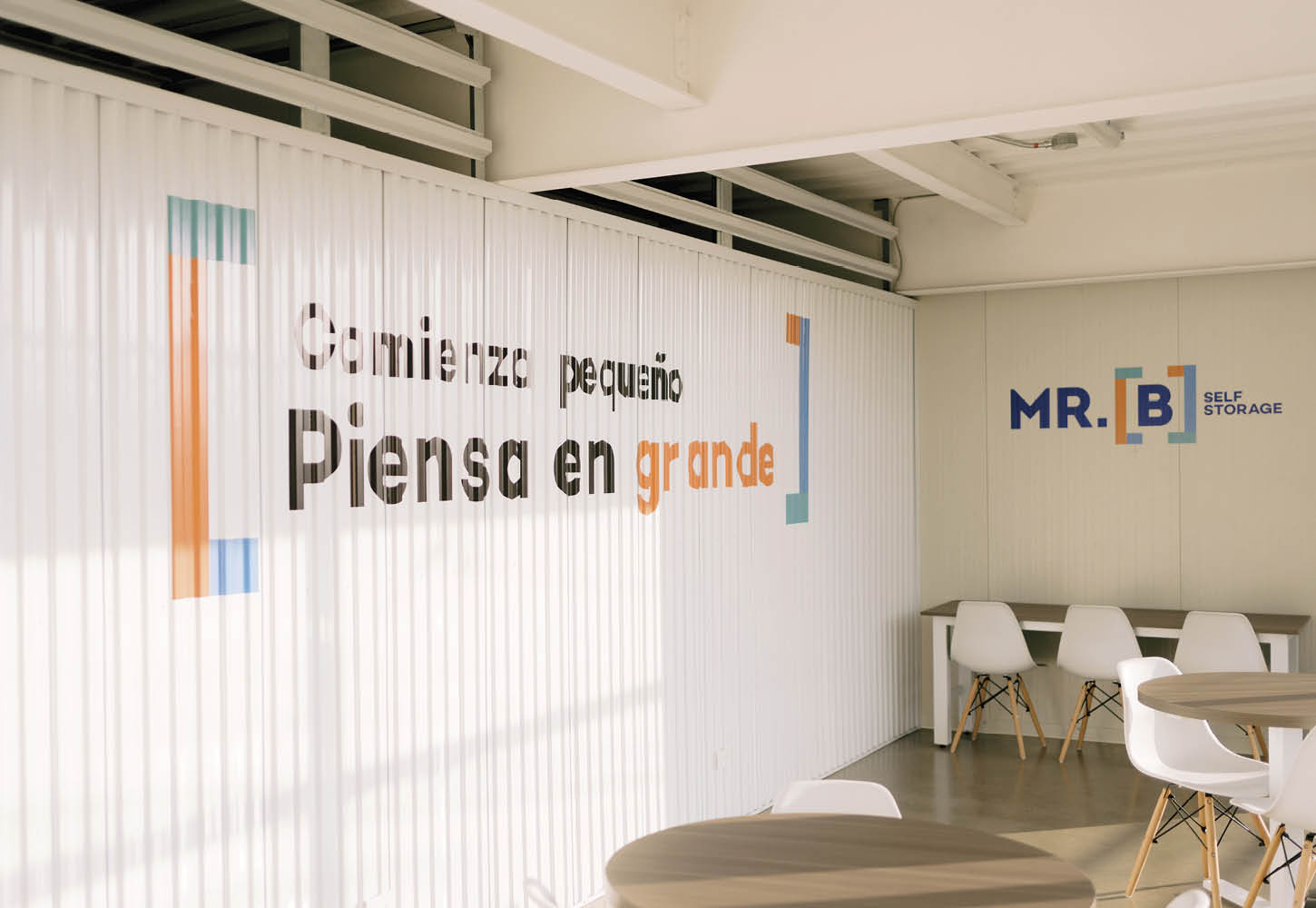



The Curridabat facility has guards on duty 24/7, along with a monitoring system on 69 cameras placed strategically throughout the facility. It includes an intercom, document reader, and access control.
OpenTech Alliance provides access control; the access control system allows customers to access the facility through their smartphones and allows Mr.[B] to better understand how their tenants are using the facility.
Gary Carland, channel development manager for OpenTech Alliance Inc. based in Phoenix, Ariz., says Mr.[B] has been a customer for several of its other projects in different countries. “They are located in various areas and countries, so the cloud software that gives them remote access is very big for them,” says Carland. “It gave them a lot of control without having actually to be local.”
The Curridabat facility used the Storage Genie app by OpenTech that allows touchless access, which Carland says is very popular in a world still dealing with COVID-19. “They had a unique situation on that facility with various levels, but we were able to provide all of the access control,” he says. “The ability to have OpenTech support was valuable to bring them online and keep them functional.”
Carland adds, “Everything that goes with Mr.[B]’s facilities always runs smoothly.” As for the tenants, they adjusted to using the Storage Genie app easily. “It’s a wonderful convenience,” he says, “and they appreciate it.”
The facility opened in February 2023. “We’re not even a year open and we’re exceeding occupancy expectations,” says Rolz. The facility is currently at 45 percent occupied, thus beating the three-year lease-up projection.
For all its marketing efforts, Brolo says the most effective of those efforts have been building good will among the community. “We try to do things in an ethical way, such as working with the neighbors and telling them we would make it right when we had the retention wall collapse,” he says. “We also installed 15 benches in the green area, and the community can walk their dogs and sit and enjoy the grounds. The community is very grateful.”
Mr.[B]’s isn’t quitting developing anytime soon. The company currently has 15 facilities in operation and six in the development phase.
Architect/Structural Engineer: Estruconsult
Builder: Eliseo Vargas Constructora
Property Management Software: SiteLink
Accounting System: SAP Business One
Access Control System: OpenTech Alliance
Doors and Interior System: SSCornerstone
Management Company: MBI Management
Escondido
Escondido, Calif.

alifornia is well-known for its strict environmental regulations, and those regulations can be arduous to navigate. Dr. Rajesh Kadakia, CEO of Greens Global, based in San Clemente, Calif., knows this all too well.
It took over two decades to conceive and develop the 2023 Green Facility of the Year, Greens Storage Escondido. Kadakia purchased the land for development 21 years ago, and many of the delays from concept to development were due to strict environmental regulations that included mitigating lost habitat for native animals and plants, as well as fostering an agreement to maintain 21 acres of bio easement directly behind the property. Those efforts alone cost Greens Global, the parent company, more than $1 million.
Once development was underway, Kadakia designed and developed a facility with sustainability in mind, living up to part of their mission statement that reads, “Value our earth and support sustainability.”
Greens Storage Escondido covers five acres and has 714 units in six buildings with an additional 124 slots for RV parking. The total project cost is more than $15 million.

Greens Global is still a family owned and operated company with over $150 million in assets spread across the U.S. and India. Kadakia primarily owns the company with his brother, Sharad, but many family members work in the business. Kadakia says the company entered the self-storage industry when the company was looking for diversification. “We had a broker who lent us money and we bought and renovated a self-storage facility and began acquiring them,” says Kadadkia.
From 2005 to 2006, the company acquired Greens Storage Rainbow. Kadakia says Greens Storage Rainbow in Temecula, Calif., was converted into the largest RV storage in Riverside County with 575 units on 9.8 acres.
In 2014, the company acquired the 76,500-square-foot Greens Storage Valley Center in Valley Center, Calif. Greens Global currently has seven self-storage facilities in Texas and California.
The company also agreed to a 21-acre bio easement directly behind the property that mandates the company maintain the creek and help protect wildlife. “We maintain the entire creek and trees on that property,” says Kadakia. “We replanted all the trees we had to take down for development and the creek is free flowing and all the water flowing into the creek is clean.”


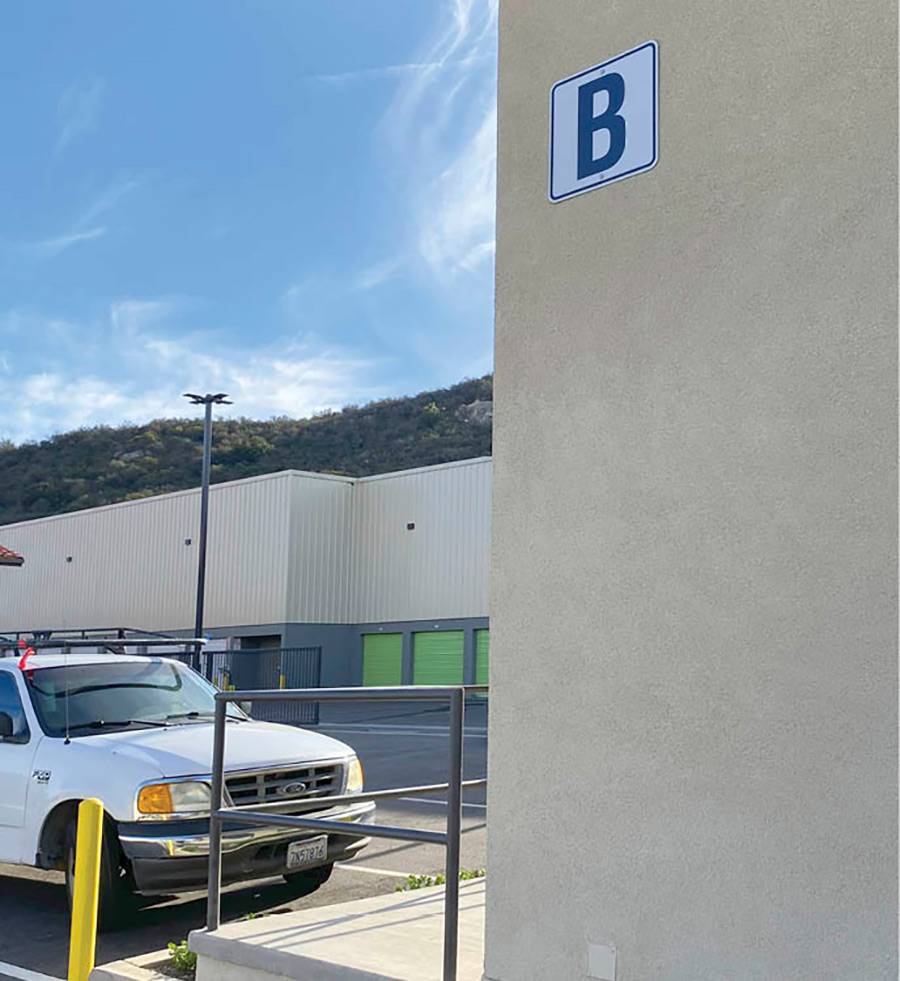

He believes the company built the most advanced stormwater drain system of any facility in California, allowing for the retention of 27,000 gallons of water in the tank. It filters it into the storm drains as clean water. The system uses various grades of crushed rock as well as modular wetland systems and biofiltration.
The system was put to the test in the past year and half when Southern California experienced some of the strongest storms it has seen in over 100 years. “The rain buried us in dirt and mud, but we managed to properly divert water throughout the storms, and we sent clean water into the drains and into the federal blue line that borders the property,” says Kadakia.
The contact system also cleans and stores water for three years, which can be used for irrigation on the property. “It’s all underground and all the drain water is clean, so it doesn’t cause contamination to the creek or, ultimately, the ocean,” says Kadakia.
The plant-based insulated roof on the buildings also has an enclosed rain gutter system that goes into the storm drainage system.
“Shortly after we made it past environmental hurdles and got approved for a major use permit, COVID hit, halting construction for months and later causing labor and supply shortages that took years to partially recover from as an industry,” says Kadakia.
As the world began to come out of the pandemic and recover, development finally began on Greens Storage Escondido. Greens Global performs all its development and construction in house, which allows the company complete control over its projects.
To clear the land for grading and construction, the company had to move 89,000 cubic yards of dirt. “We successfully crushed, filtered, and mixed rock on site to create our five-acre pad for development,” says Kadakia, “so we were able to re-use all the dirt and rock from our own site and not have to have any brought in. We also were able to export some of the crushed rock off site as well.”

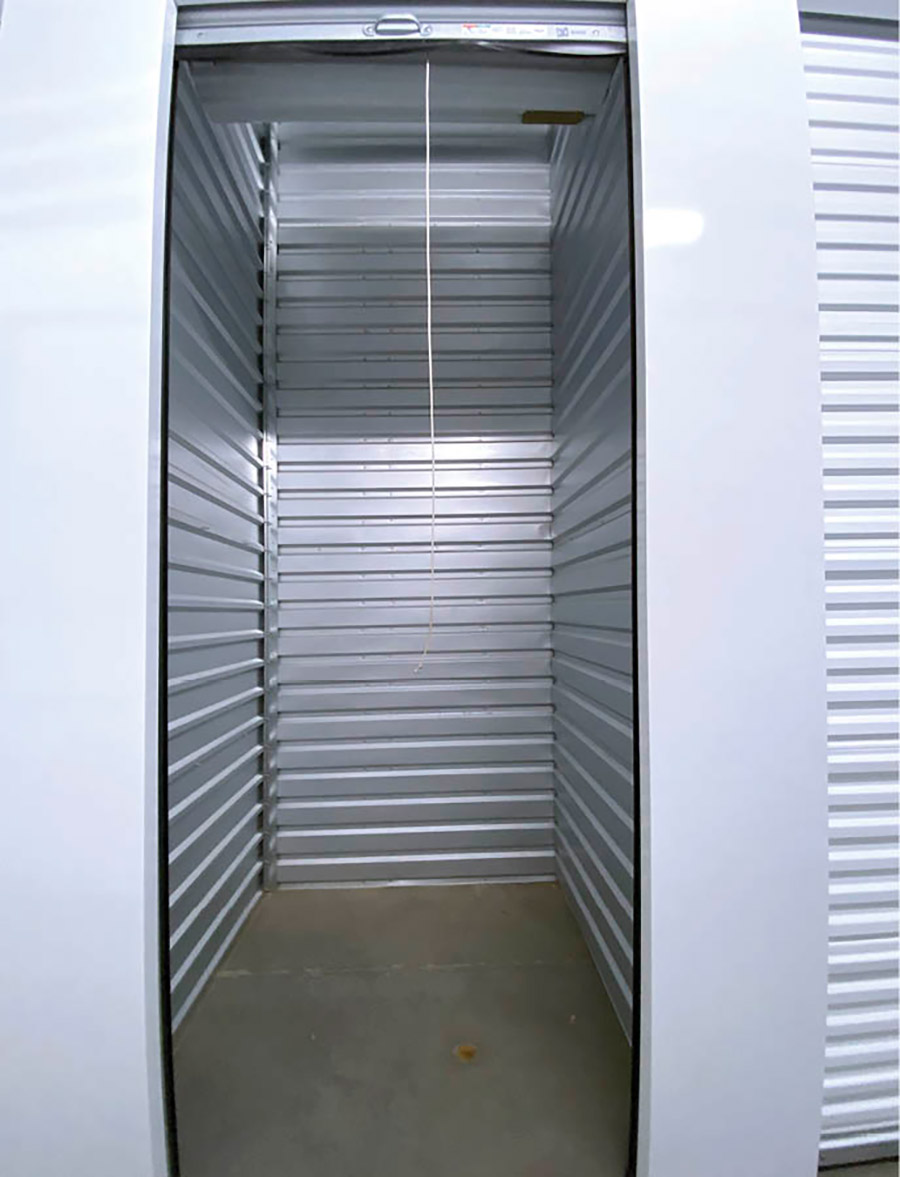

Kadakia credits his team, headed by the company’s construction superintendent, Craig Connelly, for filling in the gaps. “With over 40 years of experience in the industry, Craig was able to help finalize the design of our massive office space and do so in a way that met the design goals of the company,” says Kadakia.
Connelly worked with two structural truss engineers simultaneously, as well as the company’s mechanical engineer to coordinate the external visible trusses with the internal structural needs of the building. “He designed the HVAC system to be visible,” Kadakia explains, “with solid, painted ductwork to create an industrial look that complements the warm wood panels.”
As the project progressed, they soon realized they needed a fully ADA-accessible ramp in front of the office. “We weren’t required to include one because we don’t have a full sidewalk on the street or adjacent to us,” says Kadakia. “We see how Escondido is expanding and growing rapidly. We have a strong commitment to building things correctly the first time and anticipated we would need the ramp in the future. Craig designed a fully compliant ramp and handrail, and we got it approved.”


The property also includes EVE chargers available to tenants free of charge and an HVAC system is 16 SEER, the highest energy efficiency rating. The high-energy HVAC system allows the facility to maintain a steady 68-degree temperature, so tenants aren’t hot while loading and unloading their property.
The energy efficient office runs on a total cloud-based system, enabling the office to operate completely paperless. The energy efficiency extends to inside lighting, which automatically turns off when a room or hallways isn’t in use. As well, 36 outdoor lighting fixtures conform to dark standards, allowing the outdoor lighting to function in compliance with the nearby observatory.
- A 2,300-square-foot lobby that resembles more of a hotel lobby by being inviting and welcoming with refreshments and a friendly, trained staff.
- A full office and business center that includes a state-of-the-art conference room with high-speed WiFi and two 60-inch flat-screen TVs. The conference room allows tenants to easily set up virtual meetings with full-room cameras and microphones.
- The option of using the facility for Amazon and UPS pickups and drop-offs, as well as 77 mailboxes for rent. “This allows our tenants the option of not having to give out their personal address,” says Kadakia.
- A full retail store that carries all the supplies needed for moving, storage, and RV adventures.
- RV garages with cable television access, individual unit cameras, lighting, wall outlets, and RV charging outlets to anticipate the future of electric RVs. The units are multifunctional, capable of hosting business suites for small trades.
- RV concierge service, including picking up groceries for RV tenants and filling their RVs with gasoline, if requested.
- Fully integrated 24/7 video intercom system, which allows the staff to assist tenants, even when the office is closed.
- Golf carts for facility tours. The property will soon have drone video footage, allowing future tenants to choose their unit online.
- RV tenant services, including a dump station at nearby sister properties, propane and water filling stations, and free usage of an air compressor and vacuums.
- State-of-the-art security with 170 cameras on the property that are monitored live 24/7. The camera system, which was all done in house, includes night vision, license plate readers, and facial recognition. The system also monitors and alerts employees when a tenant isn’t at their own unit, as well as providing remote access to tenants.
- Free U-Haul truck usage for tenants, as well as wire racks for tenants to use in their units. For a fee, the facility will even provide moving assistance.




Online marketing is a critical piece of marketing for Greens Global Escondido. “We track where our customers get stuck or where they hold off on reservations,” says Kadakia. “We match it with our customers who need support most, especially for those less technologically inclined. We apply this to our online marketing strategy as well as to streamline our efforts.”

One integral part of Greens Global’s commitment is to the communities in which it serves. The company offers discounts to seniors, COVID frontline workers, military, police, fire fighters, first responders, and teachers. “We want to honor people who are the foundation of society,” says Kadakia.
Greens Storage Escondido also offers a referral program for existing tenants who refer new tenants to the facility. All these efforts have resulted in occupancy that is running well ahead of schedule. Kadakia says they hope to be at 94 percent physical occupancy by December 2024 and full economic occupancy by 2025.
Greens Global isn’t stopping anytime soon. They currently have 17 more facilities in development. Kadakia is hoping at least three of those facilities will also be carbon neutral, following the model of Greens Storage Escondido.
Builder: Greens Global/Greens Storage
Management Company: Greens Global/Greens Storage
Security Provider: Greens Global/Greens Storage
Architect: Charles Forte
Management Software: Hummingbird
Roof Provider: Sylvester Roofing
Door Provider: Janus International Group
Interior System Provider: Janus International Group

elf-storage development has taken on a life of its own, particularly after the Great Recession. Gone are the days when a mom-and-pop operator could buy a piece of land on a high-traffic area in town, construct some metal buildings, hang a sign, and wait for the income.
There’s still money to be made in self-storage development; the industry has grown to a $43.34 billion market in the U.S. However, as new investors enter the industry, many are missing the mark on what it takes to develop a successful self-storage facility, which is costly to the developer and may even create insurmountable issues for the development.
In 2022, there were approximately 1,555 completed self-storage developments that added 41.2 million square feet of rentable space to the industry. It’s unknown how many developments were abandoned at various stage due to misconceptions about where, when, and how to build a successful facility.
Misconceptions about development are many and range from what type of land is required to navigating the nuances of local government. According to experts, here are five of the leading misconceptions about self-storage development:
Build it and they will come.
As previously stated, building self- storage used to be a simpler venture, starting with having a plot of land in a high-traffic area. However, it’s more important than ever to perform due diligence to ensure the facility will eventually pencil.
First, one must identify a piece of property. A piece of land may look perfect for self-storage but have hidden issues. Gerrit Van Maanen, director of development for Spartan Investment Group in Golden, Colo., says the most important thing for land placement remains fundamental location, location, location. “You want to look for frontage and traffic counts. While marketing is as sophisticated as ever, nothing will beat a well-located facility.”
Also in the land acquisition process, Weyen Burnam, global director of real estate for StorageMart in Columbia, Mo., says you should ensure the land has complete surveys that show entitlements, setbacks, and current access, all of which may have implications for the site. One major thing to be aware of are environmental concerns. “There are more conversions now using older buildings that had previous uses,” says Burnam. “You should include a historical search on the land and an environmental search.”
In one extreme case outlined previously on a development profiled in Messenger, a late environmental discovery on an urban piece of property that once hosted a gas station led to a major unplanned remediation, which cost the developer unplanned expenses and time.
Once it’s determined if the land will work for self-storage, you must next determine if the project is financially feasible. A feasibility study should include:
- Land acquisition cost and the amount of land
- Zoning requirements for the land and what hurdles, if any, there may be with local government
- A summary of the town/city/jurisdiction in which the land is located
- A demographics analysis, which includes households, income, and other major demographic information typically within a three-mile radius
- Competition in the area should be fully evaluated
- Financial model and assumptions
- Capital expenditure sheet
- Design
- Maps, including an official zoning map of the area
- Capital expenditure schedule
Todd Amsdell, president/CEO of Cleveland, Ohio-based Amsdell Companies, which operates facilities under the Compass Self Storage name, says among the most important things such a study will show is what to include in the project. “The market is changing rapidly due to all the bells and whistles, and a developer must not only know what property is going to work but what amenities prospective tenants in an area are willing to pay for,” he says. “You need to decide on what your return on investment is you will get out of new features. If people aren’t willing to pay for the amenities, it will hurt you.”
The next step is a proforma.
Getting my project through government will be a piece of cake.
Any developer who has built a self-storage project within the past decade can tell you governments have always been a major hurdle to overcome, but the hoops many government entities are making developers jump through now are bordering on the absurd.
“Hurdles exist today that didn’t exist 15 years ago; people would be shocked by some of the things we have to go through with governments. We’re dealing now with a whole spectrum of architectural requirements,” says Amsdell, “from the number of windows a facility has to whether the facility will be carbon neutral.”
Amsdell says one of the most egregious examples is one of their most recent projects in which the government even inserted itself in dictating the number of climate-controlled and drive-up units, the type of high security and landscaping, as well as the architectural requirement that the facility match the surrounding neighborhood. “We fought them on some of it, but it was something we had never seen in self-storage development,” he says. “It’s the most expensive project we’ve built to date.”
The key to dealing with local government is to meet with them “early and often,” Burnam says. Dealing with the local government is part of their due diligence process; if the government says there is a local neighborhood association, they also meet with them. “We usually don’t even close on a property anymore unless we have all the pieces in place with the government and the neighborhood,” says Burnam.
The project will be finished on time and on budget.
“Anytime you do a feasibility study, it is an initial projection, but you must absolutely do it. Just know your project will always cost more and take longer than initially projected,” says Ann Parham, CEO of Joshua Management, a subsidiary of The Parham Group in Bulverde, Texas.
The reasons for this can include acts of nature that can delay projects to material costs being driven up due to a global pandemic. “We had an issue with suppliers on the building side,” says Adam Pogoda, president of Pogoda Companies in Farmington Hills, Mich. “The company shipped the buildings but not the doors, which isn’t normal for this company, but that’s an example of something on the supply side taking way longer than expected.” The delay in delivering the supplies caused a delay on the inspections, which put the project back several weeks.
Developers must always be willing to look at their design and see if it can be adjusted due to rising costs. “We had one project in which concrete more than doubled and we had to make adjustments to the design,” says Pogoda.
It’s advisable to be very cost conscious from the beginning of the project and project for higher labor and construction costs.
The market will remain the same as it was when I did my due diligence.
One thing about the self-storage market is that it is constantly changing, and development is taking longer than ever. “Consumer demand is always changing,” says Anne Mari DeCoster, president of Kingdom Self Storage Partners and Self Storage Investing in Scottsdale, Ariz. “Consumer behavior is also changing. Millennials are now our biggest market, and the frequency of their visits to the facility has also increased, and how they receive information has changed.” In short, you must keep up on the current trends in your area, your competition, and what is coming on line as you develop.
I won’t need an exit strategy.
No one wants to plan a facility only to have to drop the idea, but DeCoster says it’s important after you’ve done all your homework to still have an exit strategy. “If the market changes so much that the project will no longer pencil, what will you do if you have to sell before you are able to break ground?” she asks. “Always, always, keep an early exit plan in mind.”

rom the exterior, the elegant 7200 Monogram Self Storage in North Scottsdale, Ariz., looks more like a contemporary municipal building than a storage facility. Significant planning and multiple novel construction techniques were necessary to erect the 102,500-square-foot, climate-controlled building that’s owned by 1784 Holdings LLC and branded Life Storage.
In addition to two above-grade floors, the approximately 800-unit facility, designed by RKAA Architects, has two below-grade floors that required copious amounts of research, planning, and engineering. TLW Construction, general contractor for the project, employed a unique soil nails wall shoring system that required holes to be drilled and injected with steel and concrete to secure the excavation to prepare the “incredibly small site” for building construction. The foundation walls were then “shotcreted” into place against the shoring system. A carefully planned waterproofing system to prevent water intrusion and a structural cement basement ceiling capable of holding the weight of vehicles were also necessary within the basement. Above grade, the top floor extends beyond the ground floor to create covered parking. High-end finishes and high-speed loading bay doors yield a deluxe storage experience.





or the last 30 years that I have been in self-storage, the best time to get started in new self-storage development is always five years ago. This is because you would be open, occupied, and wealthy. Sure, some years you can make more and some less, depending on various factors, but waiting has never been a way to make more profits.
Presently, the economy is not running on all cylinders. Inflation is high, which means higher construction costs. Interest rates are reaching the highs of the 2008/2009 recession, and housing sales are suddenly at rock bottom. At a quick glance, you would think these are reasons to wait to build your self-storage, but they are the No. 1 reason to start as soon as possible.
We all know the stock market game is to buy low and sell high. Also, we know people often do the exact opposite. The same goes for self-storage. We now have the opportunity to “buy low” and be ready for the next self-storage boom on the horizon. It takes several months to find land, several months to get design plans and approvals, and several months for construction. Therefore, what is important is not where the economy is now but where it will be in two to three years.
Here are the top seven reasons why now is the best time to get into self-storage:
1
Timing the self-storage market (just like the stock market) is next to impossible, but if there were ever signs of a booming self-storage market coming, it is now!
2
New self-storage development is slowing. Because self-storage is a three-mile business, there is a first comer advantage for two reasons. Once a self-storage is full, it tends to stay full; good developers (and lenders) look at the needed demand and whether it is met. If demand is met, they tend to move on. If you wait, someone else may find and build on the great location near you.
3
New commercial development is almost non-existent compared to two years ago. This means land prices are not climbing like they were pre-COVID, and often you can negotiate much better land deals than in the past.
4
Self storage is one of the most loan-friendly real estate businesses. That means it is one of the few remaining commercial developments that can get a loan in good and bad times. Self-storage can be refinanced when interest rates come down. When I built my first two self-storages in the 2008/2009 recession, my interest rates were 8.5 percent. Currently, they are at 4 percent until renewal in 2028. Was I happy paying 8.5 percent interest rates? Of course not, but even at those rates it was not long before I was breaking even. I can tell you, by not waiting, I was much further ahead in the long run.
5
Expanding on No. 1, when interest rates do come down, I believe there will be a housing and economy boom, maybe unlike what we have seen in years. People moving is the largest segment of our renters. If this happens in two, three, or even four years, now is the time to start the process of finding land.
6
New technology has made self-storage operations a lot easier than in the past. We no longer must have messy on-site auctions. We can have our auctions online. The online auction provider and the legal notice provider all have API connections to our management program to keep things legal and much simpler. Our camera systems, like most systems, can be viewed from your phone or laptop and enable management to get notices when people are on site after hours. My favorite feature is that they can yell at intruders: “This facility is closed; please leave immediately. The police have been called and are on their way.”
Management reports can be as sophisticated as you desire. An aspect I like to review is a report that informs us when each staff member starts work. The variance report tells you every item that is not standard, such as charges deleted, discounted rental rates, waived fees, etc. You can use this report and other guides to help make sure there is no employee theft.
Technology provides many ways to rent in addition to your manager renting, such as a barcode on your front door, a kiosk, or your website. We are no longer limited to office hours for rentals, so we can rent more units with fewer related expenses. This empowers our manager with more time for marketing and cleaning, leading to more rentals at premium prices.
7
Self-storage is one of the greatest businesses in the world and it is typically the No. 1 or 2 real estate businesses every year. Self-storage has all the great aspects of a great real estate business, including depreciation, appreciation, amortization, and loan friendly. Self-storage takes next to no employees compared to most businesses. There are no late-night calls to repair the appliance or fix the clogged toilet. Eviction laws are simple and in favor of the self-storage owner, unlike residential properties. It is recession resistant compared to other real estate businesses. Few, if any businesses, allow you to raise your income 2 to 3 percent more than inflation.
That all being said, self-storage development is not simple and does take work and time. I like to say, “Where else can you become a multimillionaire in five years working 8 hours a week?”

ho wins? Self-storage wins every time, hands down!
The 4 percent rule lets you know the recommended value of your stock portfolio to retire with a certain yearly income via your stock portfolio. It simply states that the maximum you should spend from your stock portfolio during retirement is 4 percent. For example, if you wanted a yearly income of $200,000 during retirement you would need $5 million invested in the stock market. If you wanted a $300,000 yearly income you would need $7.5 million ($300,000 divided by 0.04) invested in the stock market.
For additional safety against the occasional large stock market drop, it would help if your mortgage was paid off and you had one or two years of income in cash. That way you could skip withdrawals when the market is down significantly.
If you have $7 million to $10 million in the market, or will soon, you are on track for a great retirement.
If you don’t see this happening, self-storage is a real alternative. And even if you have a 10- to 20-year plan to save for retirement, you can cut that time in half with self-storage.
Normally, to make $300,000-plus a year in self-storage you would need to invest $2 million to $3 million of your own money with a traditional loan with a 30 percent down payment. But now you have an opportunity to get a Small Business Administration (SBA) loan to build your self-storage business with 15 percent down, which allows you to cut your initial cash investment in half. If you would like an introduction to leading SBA Self Storage lenders let me know (Marc@storageauthority.com).
It is much easier and faster to save a million dollars to invest in self-storage than to save $7.5 million to get that same $300,000 retirement income.
Disclaimer: I am not a certified financial planner, so make sure you review your retirement funding with your financial planner. Last week we had a prospect go through our discovery process. She was all set to go and just had one step left: to check with her financial planner. She told us she decided not to get in because her financial planner said she would be risking her grandkid’s college fund. Of course, we disagree with the premise, but she made the right decision, because if she did not believe enough in herself and self-storage, then self-storage is not for her. It does take work, but most people work a lifetime and do not retire with a $300,000-plus yearly income. Many of our Storage Authority franchisees reviewed the opportunity with their CPAs/financial planners, so we encourage it. We even have one franchise who is a CPA/financial planner bidding his project out as we speak. If you would like to talk to him, let me know and I will introduce you.
Cheers! Lets crush it in 2024!

torageGives, a philanthropic, non-profit organization that connects the self-storage industry with vetted charities across the globe, announced monumental growth in charitable contributions for 2022. Through various giving formats, the self-storage community has joined forces to produce an eight-fold increase in contributions in 2022, and that number has grown in 2023. These contributions have benefited organizations such as Autism Speaks, The Sparrow Foundation, and Homes for Our Troops.
Donations in 2023 increased 900 percent through both small and large contributions of the over 600 self- storage vendors and brands who have partnered with StorageGives.
StorageGives is continuously researching organizations to support and is excited to announce the addition of Kure It, a long-time storage-focused cancer research foundation. Kure It Cancer Research was founded in 2010 by Barry Hoeven, who lost his battle with kidney cancer in 2016. It is a non-profit dedicated to providing direct funding to support the brightest minds in translational research for underfunded cancers at leading cancer centers.
Not only did StorageGives distribute over $150,000 in grants in 2023, but it grew its footprint by joining four state self-storage associations, including the Arizona, Tennessee, Louisiana, and North Carolina associations. Partnering with these and other associations allows StorageGives to expand its network of self-storage partners.
StorageGives has been committed to four causes: water, children, medical relief, and veterans.


The self-storage community doubled the number of children fed through Mission Feeding, an organization that provides meals for malnourished children in villages across Sub-Saharan Africa. Every 50 cents feeds four children, proving that each small donation has an enormous impact. The number of meals provided through StorageGives contributions doubled in 2023, equaling over 500,000 meals served.
Since 2022, these sponsors have either given through auction proceeds or by direct donation. Their sponsor level reflects their contribution and commitment to making a difference locally and all over the world. Here is the breakdown of our sponsor tiers:
- Patron – Over $10,000 (XPS Solutions, SBS Constructions, StorageAuctions.com, and MakoRabco)
- Partner – $7,500 (Universal Storage Group, Cover Commercial Roofing Solutions, Absolute Storage Management, The Williams Storage Group, Storage Asset Management, Sauls Storage Group, and Modern Storage Media)
- Steward – $5,000 (Tennessee Self Storage Association, Arizona Self- Storage Association, Texas Self Storage Association, Louisiana Self Storage Association, Freedom Storage Management, Inside Self Storage, North Carolina Self Storage Association, M. Anne Ballard, Fine View Marketing, Appletree Storage, Melissa’s Management and Consulting, The Gorman Self Storage Group, and Dynamic Solutions)
- Advocate – $2,500 (The Storage Group, The Storage Mall Management Group, Gate 5 Self Storage, and Storage 365)
- Teammate – $1,000
- Friend – $500
We thank each sponsor for their donations and the impact they are helping to make in 2023 and onward.
“I learned about StorageGives from the famous Lonnie, and his personal passion for doing good and giving back struck me. The thing I love about StorageGives is that he has the specific programs pre-picked, and 100 percent of the money goes directly to the charities,” says Ballard. “StorageGives does exactly what its name says: gives. It is incredible to see 100 percent of the profits going to those selected charities and know that by being involved you are truly giving.”
When asked if she would like to share any stories to inspire others in the self-storage industry, she said, “At the big event in New Orleans earlier this year, because my heart is all in with StorageGives, I won the U-Haul bike with a bid of $3,300. Although I will not use it, I would make that bid repeatedly because I know this money is going to worthy causes and truly giving back.”
We also had a chance to sit down with Kolin J. Van Dyne of Reliant Real Estate Management. As the director of operations – corporate for Reliant Real Estate Management, Kolin has over a decade of experience in single- and multi-unit operational management. When asked how he and Reliant connected to StorageGives, Kolin said, “Our company is connected to the cause of StorageGives because it is reflective of the diverse charitable passions we find among our employees. While everyone has different causes that they feel most passionate about, StorageGives partners with a wide array of charities, allowing everyone to identify with something that is meaningful to them.”
When asked how he would describe StorageGives to another potential donor, Kolin explained, “StorageGives is a bridge between self-storage companies and the country’s most powerful charities by making donations both practical and accessible. It is easy-to-navigate format connects companies with meaningful causes and makes supporting them easy.”
Partnering with StorageGives is simple. Operators who utilize StorageAuctions.com as their online auction vendor can choose to donate a portion of their auction proceeds to StorageGives. Vendors and other industry partners can also make a direct donation to the organization. For more information about joining the hundreds of industry partners who are making a change, visit StorageGives.org.




ecember is often the time of year when many of us start to think about resolutions for the new year. Best wishes to those who want to learn a new language or instrument in 2024.
As a monoglot with a tin ear, I do not have such high hopes for linguistic or musical ambitions in 2024. I am more hopeful, however, for the new year’s resolutions from the SSA legislative department.
For nearly two decades, the industry’s affirmative policy agenda has focused on issues such as eliminating certified mail and newspaper advertising requirements and allowing for the sale of tenant insurance. More recently, the SSA has weighed in on improvements to building codes and property tax reform. And, of course, although we do not seek out defensive issues, we always stand ready to defend operators from a variety of threats, such as rent control, sales taxes, and new mandates on your business.
You can be assured that we will continue to work on traditional proactive matters, with a particular focus on newspaper mandates and building codes in 2024, while also protecting you from negative legislation. Additionally, we will have at least a few new legislative initiatives to benefit operators in 2024.
Our newest initiatives include addressing two common concerns for storage operators:
- What to do when paying tenants are told to move out but fail to do so.
- How to ensure that a tenant is bound by a rental agreement that he refuses to sign.
Several states already address these concerns in laws applicable to residential or commercial landlords. We expect to pursue legislation to address one or both these concerns in states such as Georgia, Kansas, Maine, Utah, and Virginia.
We are also looking at reforms to provide greater clarity on how to deal with trespassers who store personal items or vehicles without permission, towing of vehicles for non-monetary violations of the rental agreement, and disposal of low-value property without a lien sale (as is already permitted by a handful of states).
Please get in touch with Daniel Bryant (dbryant@selfstorage.org) or me (jdoherty@selfstorage.org) with your feedback on these new initiatives or any other issues you face that may warrant a legislative fix.

t’s odd that I ever get the “last word,” especially at my house, so I guess it is apropos that someone who’s been in the storage business for over 46 years finally has something to say about the current state of affairs in the self-storage sector.
I’ve been asked to speak on development, the current cuss word du jour in our industry. I have lived through multiple ups and downs in the self-storage market, most of which have been brought about as a result of too much supply and not enough demand, at least for a while.
Those who have been in this wonderful business for the past few years have to understand it’s not always this fantastic. We have just been through the best of all possible times in the history of this industry, and I truly think this has been a once in a lifetime event. 100,000-square-foot stores do not fill up in 12 months; if you are not modeling three to five years, get ready for some severe pain and suffering around the corner when you see rent-ups in the 2 percent range per month.
We are not special nor recession proof, and sometimes I even wonder if we are recession resistant. We have been fortunate to have had incredible success during the past three years that, if you are paying attention, will not happen again. Hopefully you have saved a little for a rainy day, because the clouds are forming.
We are tied to many things, but most of all, transitions. Whether people are transitioning up or down in life, this creates one of the biggest sources of demand. When those transitions slow down or cease, the demand for self storage goes down with multifamily lease renewals; if people are not moving from apartment to apartment, they keep their stuff with them rather than storing them. We are, likewise, hand in glove tied to the number of home sales. If people cannot buy homes, they do not move; if they do not move, the demand for storage stagnates. This is shown very clearly where the Google Search demand for self-storage has gone down almost 20 percent below where it was in 2019, pre-COVID!
Yes, it will be a very tough couple of years until we see interest rates settle; I don’t really care where they settle, so long as they settle. You forget that a scant seven years ago, 30-year mortgages were 6 percent and our sector was doing great. It will take some time for this to happen. I see a very tough 2024, the sun coming from behind the clouds in Q1 or Q2 2025, and things relatively back to “normal” in 2026.
So my last word is, I am still on the right side of the grass and know one thing: When man plans, God laughs, and he is chuckling right now. Be flexible with your plans. If you must develop, remember: I have never seen a self-storage facility fail if from the front door you can smell McDonald’s and see a Walmart.





































